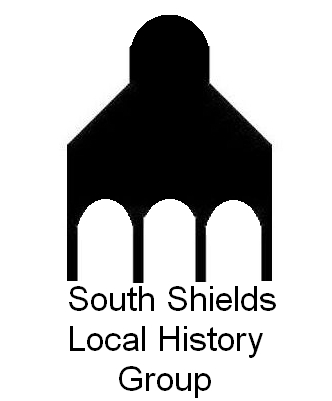The following article is based on Amy Flagg’s:
“Photographs of damage by enemy action in the Borough of South Shields. 1940 to 1943” available in The Word.
Amy Flagg’s own photographs taken on the day of the air raid or shortly after the raid.
Shields Gazette articles appearing the next day after the air raid; though because of wartime censorship South Shields is not mentioned by name usually as a “North-East Coast Town”.
An account compiled chiefly from Official ARP Reports on “Incidents”.
1940.
January 11. No sirens.

It was shortly after 10.00 hours that South Shields felt the first impact of warfare by the Luftwaffe. The Air Ministry announced:
“Enemy air-craft crossed the coast near Newcastle today. No bombs were dropped. Fighter patrols were sent up and Anti-aircraft guns opened fire.”
Shrapnel fell in the streets of South Shields. An enemy air-craft, flying at a great height, came in from the sea and was driven off by heavy Anti-aircraft gunfire. Large black smoke puffs were seen in the sky, concentrated on a plane travelling in a westerly direction. After apparently completing a wide circle, it appeared again and was fired on. Six British fighters went in pursuit.
1940 June 21. 23.50. to 02.10.
Four High Explosive bombs dropped on a field near the junction of Marsden Road and Centenary Avenue. Several houses were slightly damaged by shrapnel. There were no casualties.
1940. August 9. 23.59. to 02.57.

One H.E. bomb fell in a garden at the back of Lawe Road near Pearson Street. Four people in an Anderson shelter 10′ from the crater were uninjured.
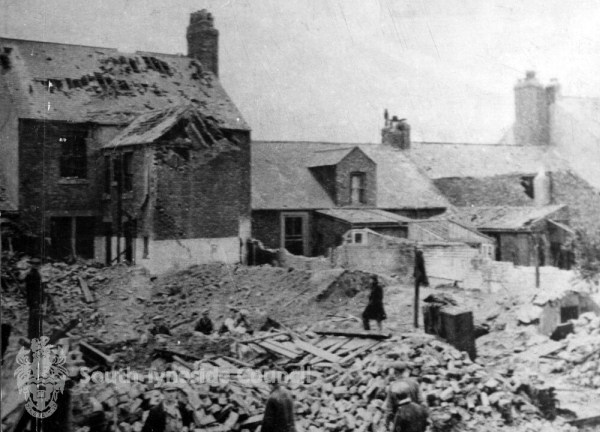
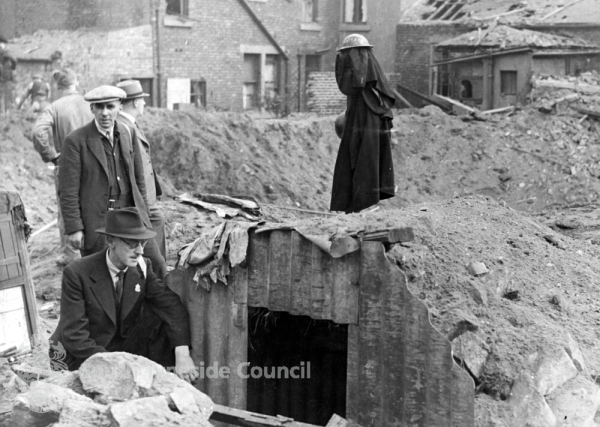
One Home Guard was killed by machine-gun fire. No casualties from the bomb.
1940. August 15. 12.49. to 14.09.

The “Battle of Tyneside”, in a way the prototype for the “Battle of Britain”, did not affect the town; indeed, many people had very little idea how momentous an occasion it was. The roar of planes and heavy gun-fire were heard; there were occasional glimpses of air-craft attacking or taking evasive action but bombs were only dropped in the harbour, on the cliffs and at sea. Four H.E. bombs fell at Salmon’s Hall & Frenchman’s Bay. A Coast-guard on duty had a narrow escape, one bomb falling on each side of his cabin which was seriously damaged. No casualties.
August 20. Nil. to 01.34.
A “Whistling Type” bomb fell on Cleadon Golf Course, (Durham County area).

Slight damage from rock splinters to houses in Fellside & Cragside were reported. 3 or 4 Barrage Balloons broke away during the raid, damaging roofs in the West end of the town. There were no casualties.
1940. August 25. 01.40. to 05.12.
About 15. H.E. bombs fell in the Borough. Some fell near the Gas Works where 1 fire resulted but was soon put out. About 200 people were rendered homeless due to damaged dwelling-houses in Derby Terrace, Percy St., Readhead St., Pontop St., and Claypath Lane.

Damage was also done to stables in the area and some horses were killed.

Telephone, gas, water & electric mains were involved. Ministry of Health Feeding Centres were used for the first time. 1 H.E. bomb fell in Mowbray Road and others in the neighbourhood of St. Hilda’s church and Coronation Street. Casualties. 1 Fatal. 19 injured.
1940. August 26. 01.50. to 03.15.
3 small bombs fell on fields near Marsden Bay.

No casualties.
1940. September 21. 01.44.to 00.38.
A land-mine fell in Beach Road on the edge of the Bents Park. Water & electric mains were damaged. No casualties reported.

1940. October 10. 19.55. to 21.55.
2 H.E. bombs fell & exploded in the river 50′ astern of the block-ship “Melba” lying at the Groyne Quay. No casualties.
1940. October 24.
2 unexploded sea-mines, British make, were washed up on the South Beach; one 400 yds South of the Pier; the other 100 yards North of Trow Rocks. Both were disposed of by Admiralty officials.
1940. December 14. Nil to 03.47.
An A.A. shell fell in Tadema Rd., damaging 2 houses. Two people were taken to hospital suffering from shock. No other casualties.

1941.
January 30.
One mine was cast ashore & exploded 50yds South of the Pier. No casualties.
1941. February 15. 23.08. to 05.55
This night will be long-remembered in South Shields. 130 enemy aircraft were engaged in an action on the coast from Hull to Berwick. Bombers & mine-layers came over in waves and were met with intense A.A. fire.
At 00.25, a Heinkel III. was hit by gun-fire & collided with a Barrage Balloon cable on the North Foreshore. Part of 1 wing was broken off & fell on the shore. The plane lost height very quickly and crashed in Beach Rd., exactly on the crater made in 1940. One member of the crew baled out but his parachute caught on overhead wires & he hung downwards until rescued. He was badly injured & died shortly after admission to the Ingham Infirmary.

The remainder of the crew perished with plane which burst into flames on impact with the ground.

At 00.50., a mine, which had not been released from the bomb-rack of the plane, exploded with terrific force. Some idea of the explosion may be gathered from the facts that it was seen and heard from beyond Newcastle and many windows were broken as far away as Tynemouth, North Shields, Westoe and Laygate.
The Model Yacht House in the South Park and a small building were completely wrecked; and parts of the plane, maps, papers & clothing were subsequently collected from the South Park and dredged from the Lake.
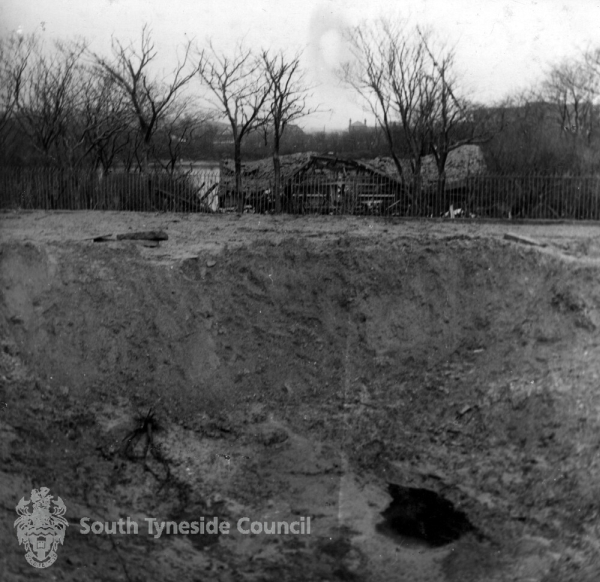
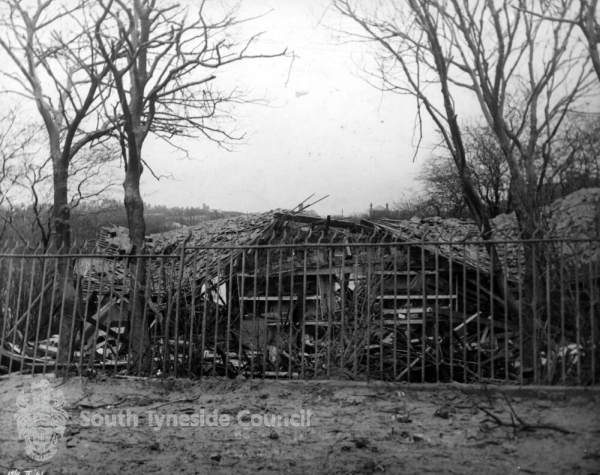
Unhappily the explosion had tragic results; one officer of the Borough Police Force & one Auxiliary Fireman were killed; two other members of the A.F.S. died in hospital. Seventeen more members of the Police Force, Fire Brigade and Auxiliary Fire Service were injured, some very gravely, and were admitted to the Ingham Infirmary.
Other enemy aircraft, apparently taking the flames as target, dropped bombs on Brodrick St., where an elderly couple lost their lives and several houses were demolished; and on the junction of Lawe Road and St. Aidan’s Road.

Damage was caused to a number of houses; “Sea Marge” & “Tyne View” being completely wrecked; and to St. Aidan’s church. During the same raid six Parachute mines descended on the South Sands near Trow Rocks, and on some fields near the New Marsden Inn, but caused no damage or casualties.
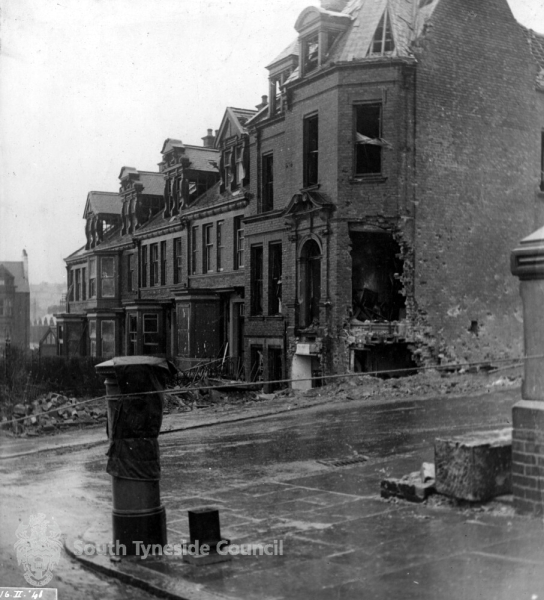
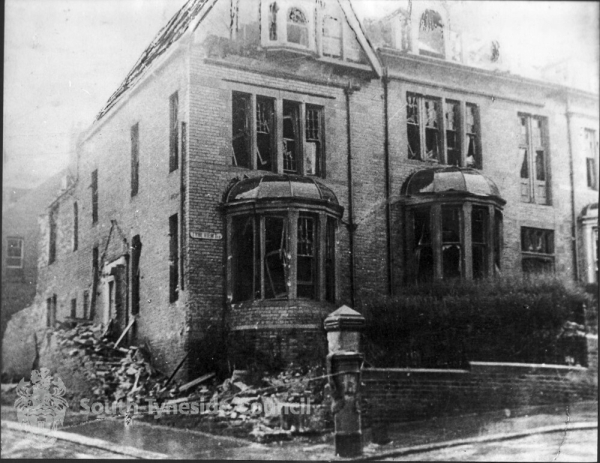
Bombs and Casualties. H.E. bombs fell as follows:-
| Time | H. E. Bombs fell | Killed | Injured |
| 00.36 hours | 1 on Brodrick Street. | 3 | 2 |
| 00.55 hours | 1 on St. Aidan’s Rd. | 0 | 0 |
| 01.05 hours | 1 Redwell Lane | 0 | 0 |
| 02.30 hours | 1 on South Sands | 0 | 0 |
| 03.13 hours | 1 on South Sands | 0 | 0 |
| Plane explosion | 4 | 17 | |
| TOTALS | 5 bombs | 7 | 24 |
Many houses were severely damaged and widespread breakage of windows was suffered in many parts of the town. 85 people were rendered homeless, some of whom were taken to an Emergency Centre.
1941. April 7. 21.04. to 03.12.
H.M.S. “Manchester”, waiting in Jarrow Slake to convoy the new Anti-aircraft Carrier “Illustrious”, may have been the objective of the two disastrous raids in this week; but it proved quite ineffective so far as the naval vessels were concerned, no hit being scored on either. Considerable damage, however, resulted along the river-side from Tyne Docks to the Oil Tanks, as well as other parts of the town.
Immediately after the “Alert”, enemy air-craft became very active & there was an intense barrage from ground defences. At 23.45 hrs, 4 H.E. bombs of medium calibre were dropped on Messrs Henry Wilson’s timber yard, Tyne Docks; Messrs Clayton & Armstrong’s timber yard, Tyne Docks; the Anglo Iron Foundry, Tyne Dock; and a dwelling-house & shop in Porchester Street.

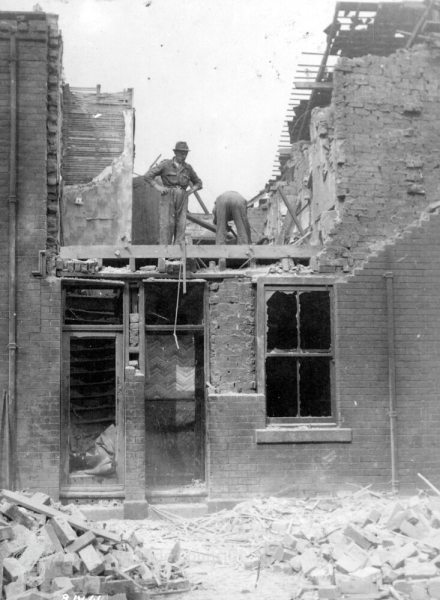
Four unexploded bombs were found; in a field near the Pumping Station, Marsden Rd.; Harton Cemetery; Harton House Rd.; and the Readhead Park. All were dealt with by B.D.S. in due course. Casualties. 1 Fatal. 6 Seriously injured. 11 Slightly injured.
1941. April 9. 23.25. to 04.30.

Shortly before the siren sounded, enemy aircraft were heard, ground defences became very active and 2.H.E.bombs were dropped at Clyveden Rise, one of which wrecked two houses and damaged several others.

Then came a shower of Incendiaries, an estimated number of 6,000 falling in the Tyne Dock area, through the centre of the town & over the Mile End Rd., River Drive & Wapping St. district. It soon became clear that a large-scale attack was developing and directed mainly on the ship-building, ship-repairing and timber yards on the riverside.
After this a series of Flares were dropped, illuminating the whole region? Major fires were started on the West side of Tyne Docks, Readheads’ yards, the Middle Docks, the Tyne Dock Engineering Co., Wardle’s timberyard and Brigham and Cowan’s Store Shed. The Queen’s Theatre, the Railway Station tower and houses in Fawcett Street & Robertson Street were ablaze; Houses in Westoe Rd., Tyne Dock & East Jarrow also were involved.
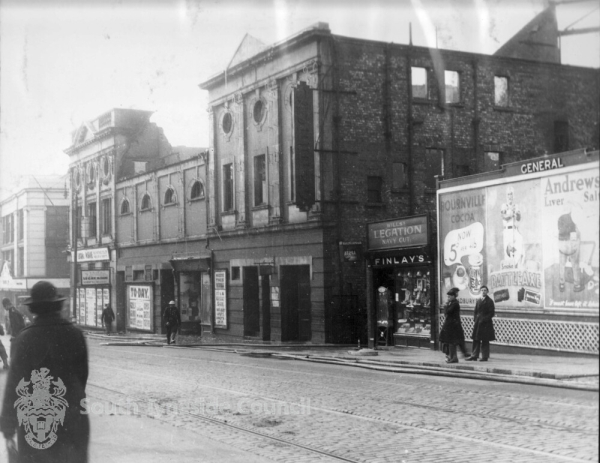
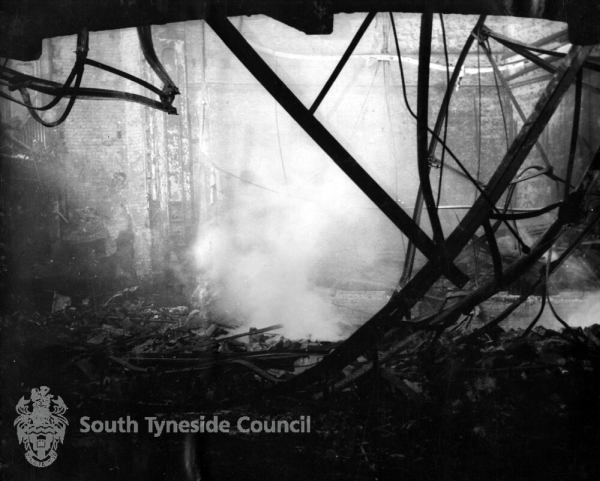

Owing to the nature of many premises affected, the resources of the Fire Service were fully extended and a call for “Mutual Aid” had to be made. Fire Brigades from Durham, Gateshead, Middlesbrough, Newcastle and Sunderland arrived, each town sending their requisite complement of Rescue & First Aid Parties.
During the progress of this Blitz by fire, a large number of H.E. bombs dropped, causing great havoc at various points. The largest number of casualties were found in the Mile End Rd. Area, including Empress St., Palatine St., Fort St.& William Terrace. 2 large calibre bombs fell close together in this thickly populated part, completely shattering a whole block of houses, but it was fortunate that no-one in the surface shelters, which were within 25′ of the craters, was seriously injured.
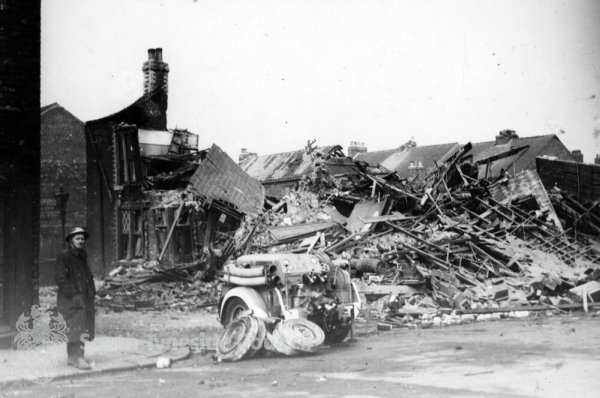
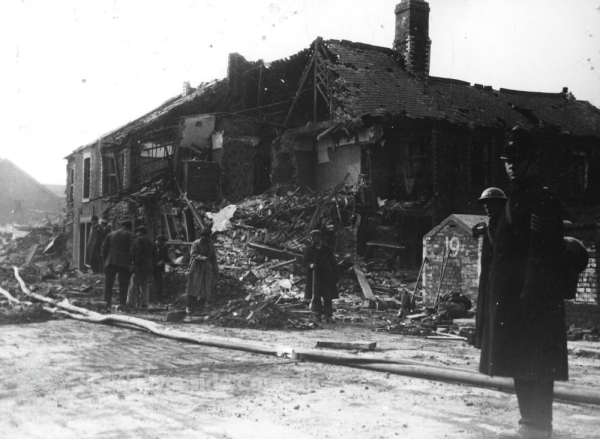
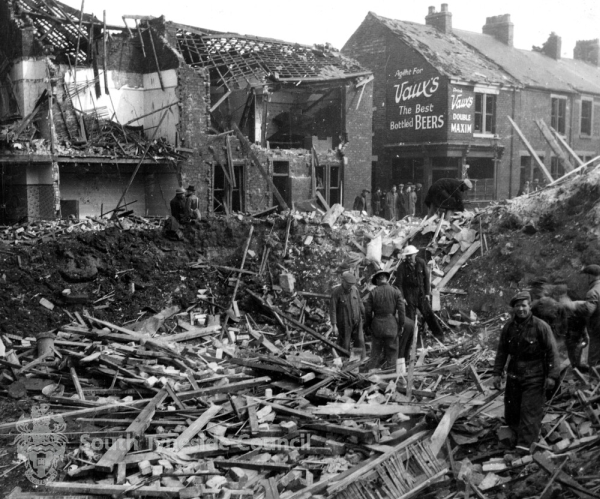
Bombs also fell on the railway line near Studley Bridge & Ellesmere St., where passenger coaches were flung about like toys;
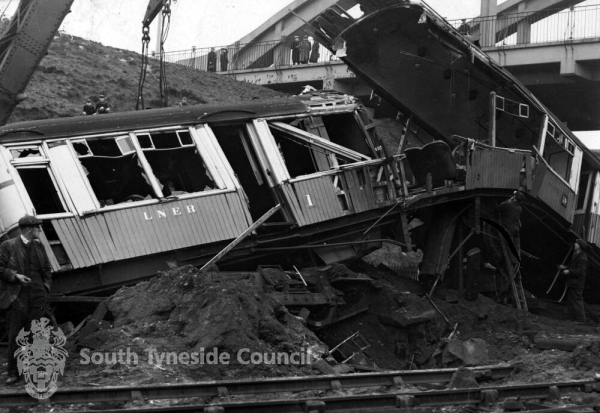
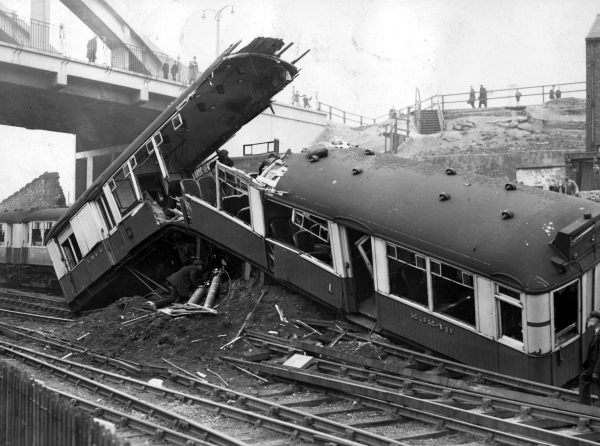
On Harper St. & Pearson St. where one bomb fell & exploded 20′ from a surface shelter which was moved 9″ at its base & sustained a 9″ crack in the dividing blast wall. No-one occupying this shelter was harmed.
Several bombs fell in Readhead’s yards, doing much structural damage; in Clayton & Armstrong’s timberyard; in the T.I.C. Dock; on the Middle Docks and a Fire Station; in Anderson St. & on the Battery Field at Westoe.
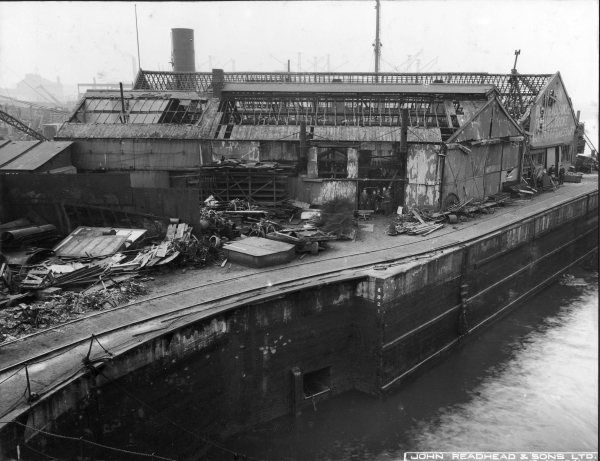
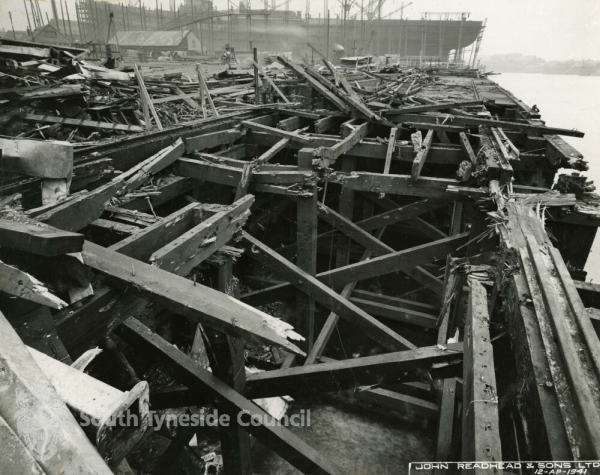

In King George Rd. two houses were obliterated and at the Deans, Prince Edward Rd. W. was blocked by a large crater on the embankment below Dean Terrace. At the back of the Police Headquarters, a bomb fell in Oliver St. A water main burst, filling the crater with water & burying a motor car in mud.
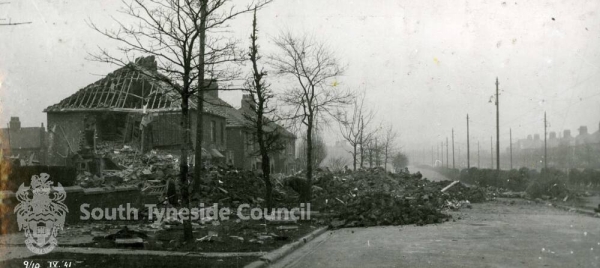
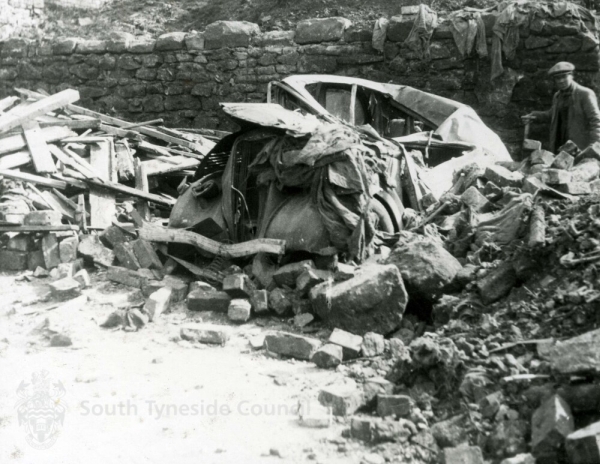
One of the largest bombs dropped in this country to date, was found unexploded in Newton & Nicholson’s premises, Templetown. It was a 1,800 kg. Gen. Purpose bomb, recognised as a “Satan” and it had penetrated 55′, made up of 20′ straight drop and 25′ jink.
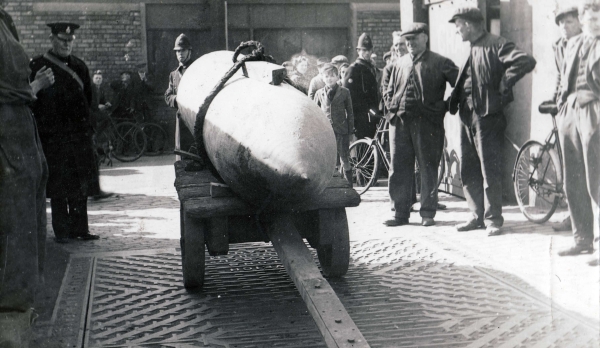
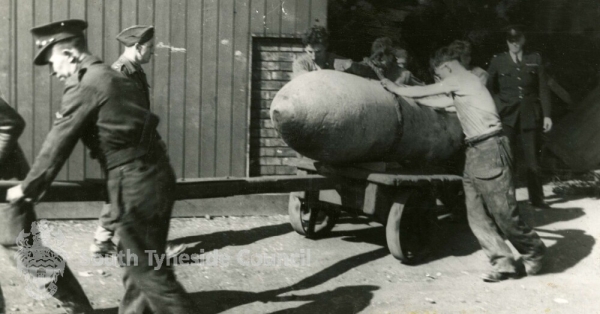
Another unexploded bomb was found in a garden in Dean Crescent; it had ripped off the outer walls of a house in its descent. Both these bombs were dealt with by the Bomb Disposal Section.
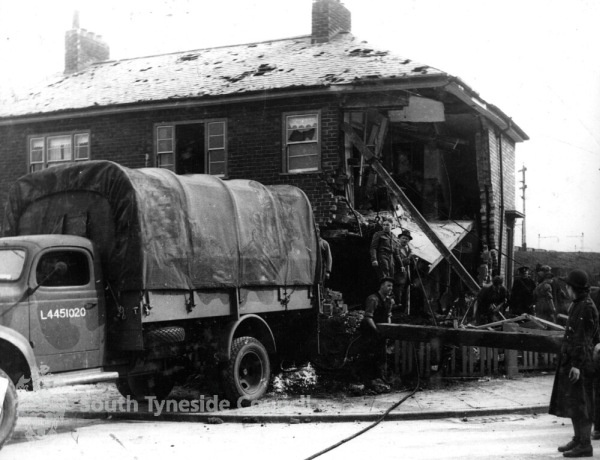
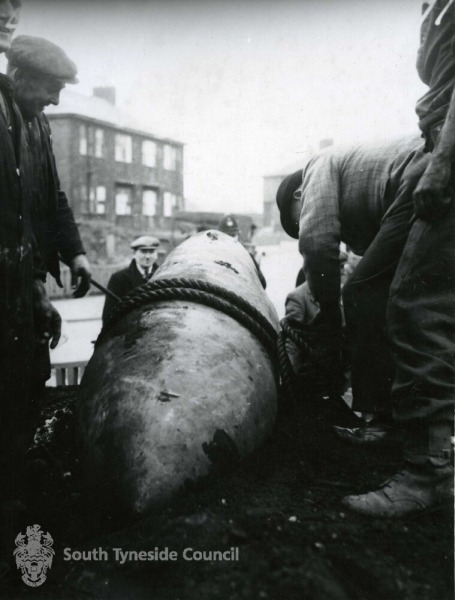
The estimated number of bombs dropped was 38, but this does not include many which fell in the river, the harbour and the sea near the Pier. About 70 enemy planes took part in the raid.
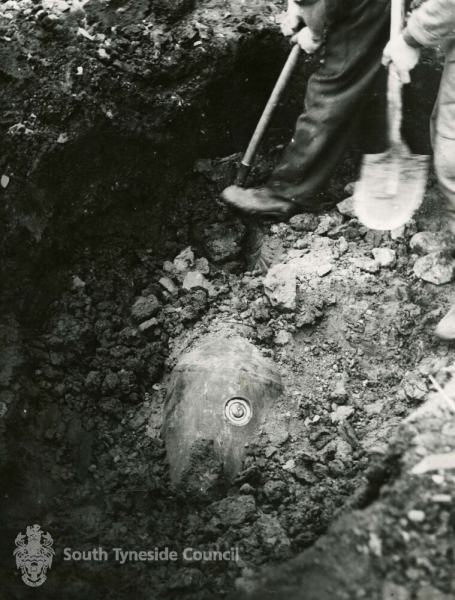
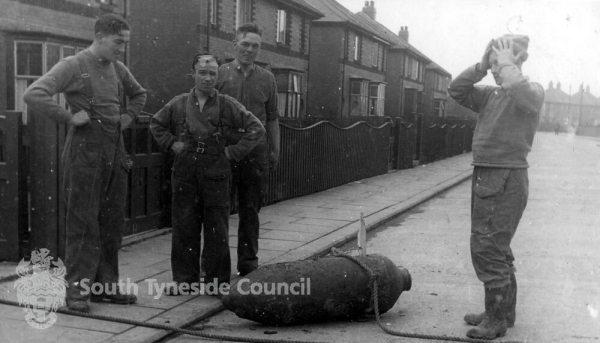
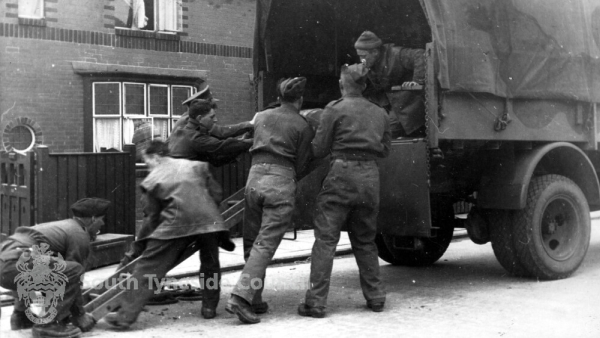
50 people were rendered homeless or evacuated. Two Rest and Feeding Centres were opened & maintained until all were housed elsewhere. On the following morning a request for the help of fifty men was made under the Police Mutual Aid Scheme; 2 Mobile Canteens also came to supplement local arrangements for the feeding of personnel.
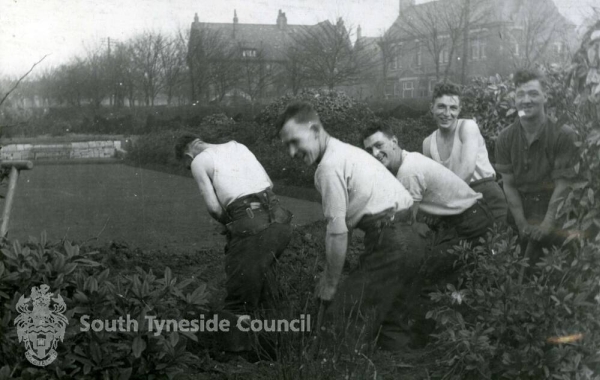
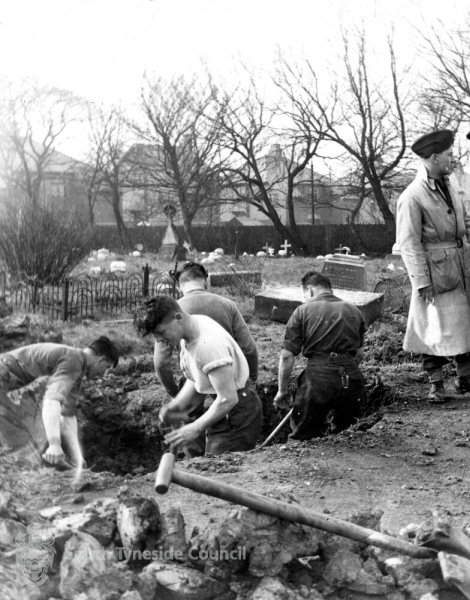
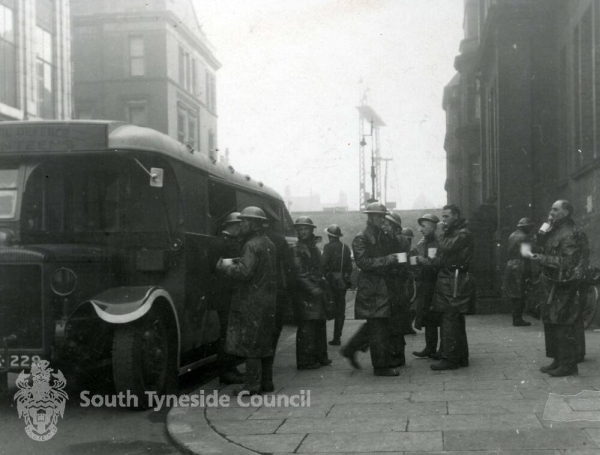
Water & gas mains, electric cables & sewers were damaged in various localities; also the telephone cables were put out of action, greatly hampering communications during the heaviest part of the raid.
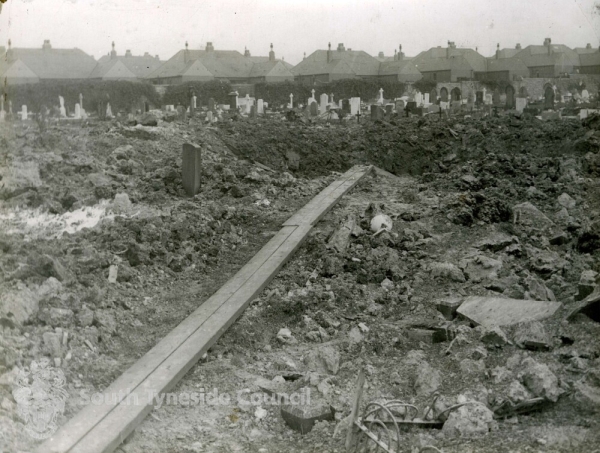
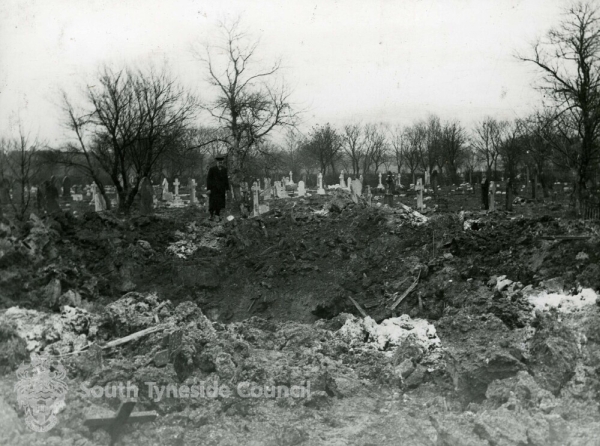

| Casualties | Fatal | Seriously injured | Slightly injured |
| Male | 9 | 10 | 51 |
| Female | 11 | 1 | 11 |
| Children | 2 | 0 | 3 |
| TOTALS | 22 | 11 | 65 |
1941. April 14. 21.27. to 21.50.
A shower of Incendiary bombs, estimated to number 600, was dropped over an area from the Town Hall to Morpeth Avenue. All fires started by these bombs were dealt with at once by the Fire Service and the Civilian Street Firefighting Parties then in operation. Within a very few minutes after the fall of the bombs, all had been dealt with effectively, thus preventing any illumination to guide any following air-craft.

No H.E. attack was carried out, probably as a result of this prompt action. One point of interest was that a new type of I.C.B. Container was jettisoned by a plane which appeared to be in difficulties, being hotly engaged by our Fighters. This Container, which had four bulkheads each capable of holding 80 Incendiaries, fell in the back-yard of a house in Hepscott Terrace. Two other containers, both badly damaged, were found in different parts of the town. No casualties.
1941. April 14.
Sunniside, Unexploded Mine.

1941. April 25. 21.55. to 23.40.
This raid, though short in duration, was notable for the number of Parachute Mines dropped and the consequent large areas of damage from blast. The attack began by the fall of approximately 2,000 Incendiary bombs on the docks and river-side, Robertson St., John Clay St., Imeary St. and the Laygate district. Some small fires were started but they were soon under control and caused little damage.
Following up this attack, seven Parachute Mines were released over the following places: one on a house at the junction of King George Road and Lascelles Avenue, which demolished three semi-detached villas and damaged roofs and windows of houses and some wood structures nearby.

A second mine fell on the Y.M.C.A. Recreation Ground at Harton, making a small crater but causing severe damage to Ambulance vehicles dispersed round the field, and to hundreds of houses in the neighbourhood.

Another fell in a field 200 yds south of the New Horsley Hill Hotel but apart from structural damage to houses in this area nothing serious ensued. Three other mines fell on or just outside the confines of the Borough; in a field half a mile south of the Holiday Camp at Marsden; near the old Marsden Inn, which had been evacuated; and near the Water Works Tower on Cleadon Hill, respectively. One which did not explode, was-found in the field between Cleadon Hill and the Cleadon Cottage Homes and was disposed of later in the day by the Naval Bomb Disposal Squad under the direction of Lt. Apps, R.N. Two more mines descended near the South Foreshore; one falling into the South Marine Park Lake, causing a mighty splash of water and mud when it exploded, and the other near the Promenade and Sea Hotel. The latter was severely damaged for the third time, nearly all the interior fittings being destroyed.

A stick of four H.E. bombs was dropped in the Green Lane area. The first on a field near High Simonside Farm; the second on a house in Green Lane.

The occupants of the house were in an Anderson Shelter in the garden; the shelter was damaged but only one casualty resulted. Evacuation of a large number of residents in this district was necessary as the third bomb, which fell in a field nearby, failed to explode. The fourth exploded near a hedge dividing two fields about a quarter of a mile West of High Simonside.
| Casualties | Fatal | Seriously injured | Slightly injured |
| Male | 5 | 15 | 36 |
| Female | 2 | 3 | 10 |
| Children | 1 | 0 | 4 |
| TOTALS | 8 | 18 | 50 |
1941. May 3. 23.03 to 03.13
Shortly before the siren sounded, approximately 600 Incendiary bombs were dropped between the Stadium, Westoe, and the Horsley Hill Estate. The few small fires which resulted were extinguished by the Street Fire Fighting Parties. As a result of this prompt action, probably, no H.E. bombs were dropped in this raid. (The series of long Alerts during this week was due to the large-scale attacks on Liverpool.)
1941. June 6. 15.20 to 15.46.
At 15.00 hours an enemy air-craft dropped one 500 kg. bomb 20 yards West of the L.N.E.R line at East Jarrow. Two pigs and a number of hens were killed by blast. No other damage or casualties were reported.
1941. June 25. 01.18 to 02.40.
One 250 and two 500 kg. bombs fell in the Harton Cemetery Extension. No damage was caused and there were no casualties. These unexploded bombs were dealt with in due course. The third bomb fell in the Penshaw district.

1941. September 7. Nil. to 03.59
(1) A “Sneak” Raider, said to have followed after some of our own aircraft, dropped 2 H.E. bombs at 03.30.; one in a back lane between Charlotte St. & Franklin St.; another on vacant land at the West end of Mount Terrace. Both bombs failed to explode but damage was done to walls, water & gas mains, etc. No casualties resulted but a large number of people had to be evacuated pending the removal of the bombs.
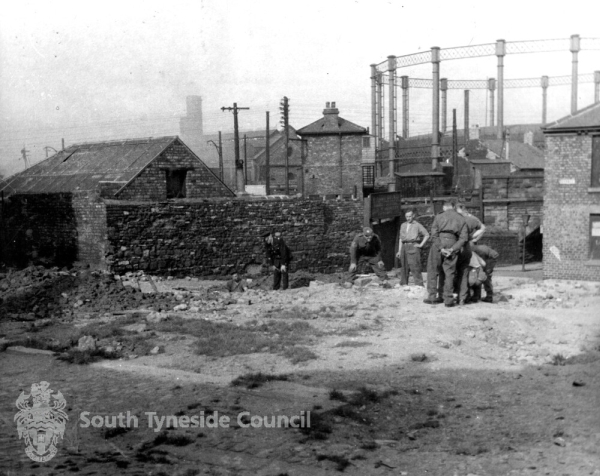
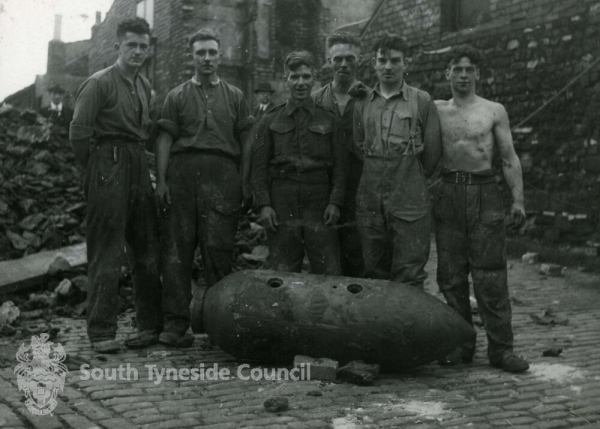
(2) 21.59. to 23.50.
On the same day at 22.20 hours, 2 H.E. bombs were dropped on the Bents Park. Some damage was done to the Royal Observer Corps Post; a large crater was formed and one man was slightly injured.
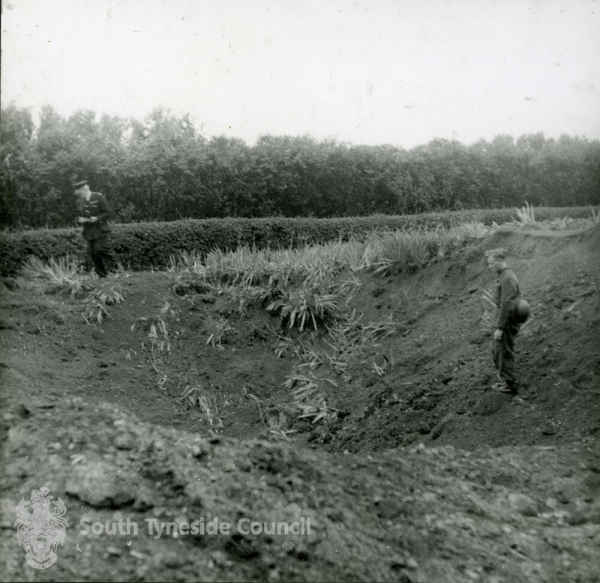
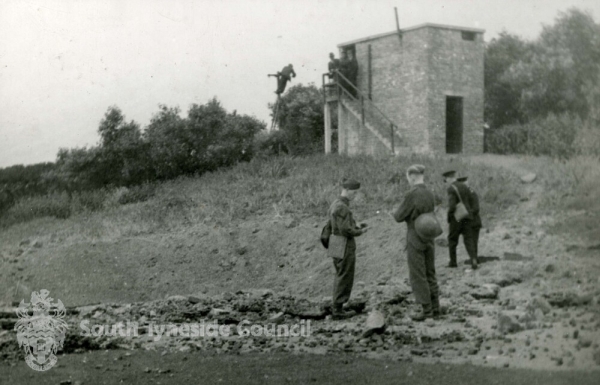
1941. September 8. Nil. to 03.25. & Nil. to 04.30.
One 250kg.bomb fell in a field near the old Marsden Inn but did not explode.
1941. September 30. 20.52. to 23.00.
“Enemy activity over this country last night was not on a large scale, but included a fairly sharp attack on a North-east coast town. Considerable damage was done and there were a number of casualties, some of which were fatal. One enemy aircraft was destroyed during night.” Behind this terse statement by the Air Ministry and the Ministry of Home Security, (Oct.1.), lies a story of widespread bombing, some miraculous escapes and many acts of individual heroism in South Shields.

At 20.52 hours on this evening a stick of bombs fell on North Shields, two major fires being started. Seventeen minutes later the attack was carried to South Shields when a 1,000kg. bomb fell in the garden behind the “Simonside Arms” on the Newcastle Road. A crater 50’x 15′ was made and 90′ of a wall demolished, but the explosion only caused superficial damage to the hotel and some breakage of windows in houses nearby. There were no casualties.

At the same time two bombs fell in Commercial Road; one struck the foundations of an old house on the bankside below Smith’s Foundry, ricocheted, passed through the exterior wall of a house on the opposite side of the road and came to rest on the floor of an upstairs room between a partition wall and the bed.

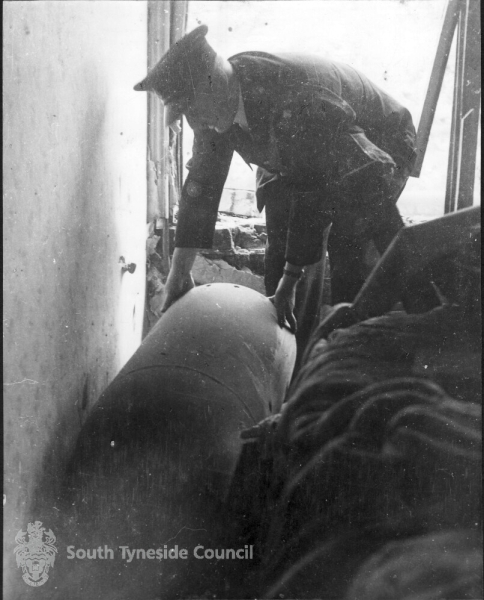
In the course of its flight the base plate and fins of the bomb were broken off but it weighed 500 lbs without them. It was removed by the Bomb Disposal Squad next day. The other bomb hit Holy Trinity Schools, completely wrecking the buildings and blocking the road with debris.

A gas main was burst, the windows in Holy Trinity Church were shattered and structural damage was done to other buildings in the vicinity.
A few minutes later, a 1,000kg. bomb fell immediately behind four houses in Harton Lane. These houses, which were reduced to rubble, covered a frontage of 86′. There was one fatal casualty, a woman who had remained in her home during the raid but the other occupants of the houses, who had gone to their Anderson shelters, were unharmed.

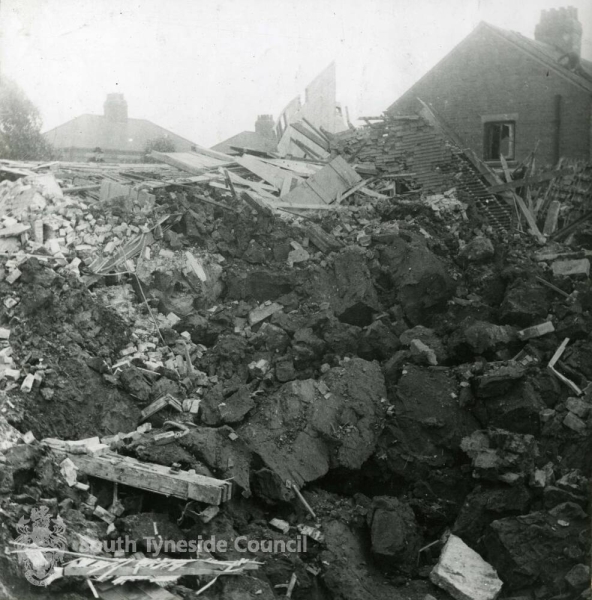
A gas main and a water pipe were fractured. Other houses in the neighbourhood were damaged. At Harton Dye Works, the main buildings were completely wrecked by another 1,000kg. bomb which fell in the centre of the works; all the heavy machinery in the Laundry was destroyed and much harm done to surrounding departments, necessitating further demolition. There were no casualties. Three more bombs fell on the fields bounding Prince Edward Road; one, between the Royal Engineers hutments & the Searchlight Battery on Brinkburn Farm field, caused no damage to the hutments or the lights but a soldier on sentry duty was wounded. The other two bombs fell harmlessly in fields.
At 21.20 hours, Union Alley received a blow which was later to prove providential. It fell near the Market Place entrance, behind Crofton’s warehouses. A café at the corner was totally obliterated and a number of people were trapped in a basement. A Rescue Party Foreman, who afterwards received the George Medal for his gallantry, was lowered head first into the cellar and succeeded in rescuing three people.

“In spite of a concentration of coal gas from a broken main, & the possible collapse of heavy masonry, he continued searching for the remaining victims. One youth and an elderly woman were found & extricated but another woman was buried up to her neck and in danger from the likely collapse of wreckage. Without hesitation he placed himself in a position to hold up the unsafe debris and maintained this until the casualty was removed.”
The rear of Crofton’s premises was badly damaged, rolls of lino, carpet and other goods being flung considerable distances. The roadway at the entrance to Union Alley from the Market was completely blocked by the large crater, and debris.
Another heroic deed resulted from a stick of bombs which fell at 21.21 hrs., near West Holborn. One bomb, 1,000kg., fell through the corrugated iron roof or the Electric Power Station; it hit and demolished a 22½” wall 16′ high, twisted a steel girder contained therein, and came to rest on the manhole of a boiler, (steam pressure of 250 lbs). It failed to explode but there was great danger of it doing so owing to the heat of the boiler. A Corporation employee very courageously drew the fires and at 04.30. on October 1st, it was removed by the Bomb Disposal Section and dispatched to Newcastle as, owing to its damaged state the Officer in Charge was unable to remove the fuse. Throughout the remainder of the raid the whole town was without electric light and the activities of Rescue Parties, First Aid and Ambulances were severely impeded. The “All Clear” at the end of the raid had to be sounded on sirens on Police cars. Another 4,000 kg. bomb fell in No.3.Dock at the Middle Docks, passing through the side of a ship into the dock bottom. Another of the same size fell on the West side of the Middle Docks, completely wrecking the Middle Docks Canteen, demolishing the Whitehill Landing Stage; it sank the Ferry with four of her crew on board. Severe damage was also done to surrounding premises.
Widespread havoc was caused by another heavy bomb which fell in the back between Morton Street and Livingstone Street. 34′ of property was shattered and an additional 79’ had to be taken down later. A number of the casualties in this thickly populated area were fatal. Water and gas mains-were damaged.

About 21.30., three bombs fell at Trow Rocks and a fourth near Frenchman’s Bay. This stick was in close proximity to the Fort but there were no casualties or material damage. Another bomb fell near Rydal Gardens; two houses in Ambleside Avenue were completely destroyed but some of the inmates had a remarkable escape. Seven people were just going to the Anderson shelter in the garden and were actually in the hall of their house when the bomb dropped; they were trapped at the foot of the stairs and were eventually got out by a Rescue Party and Wardens; when it was found that two were dead and two needed hospital treatment; the remainder suffered from shock. Gas mains were affected and a fire started which was extinguished by the N.F.S. Water mains were also fractured.

A large area of property was devastated when the Shields Gazette Offices & printing Works received a direct hit by heavy calibre bombs. The whole of the Printing Department was wrecked and part of the Offices.
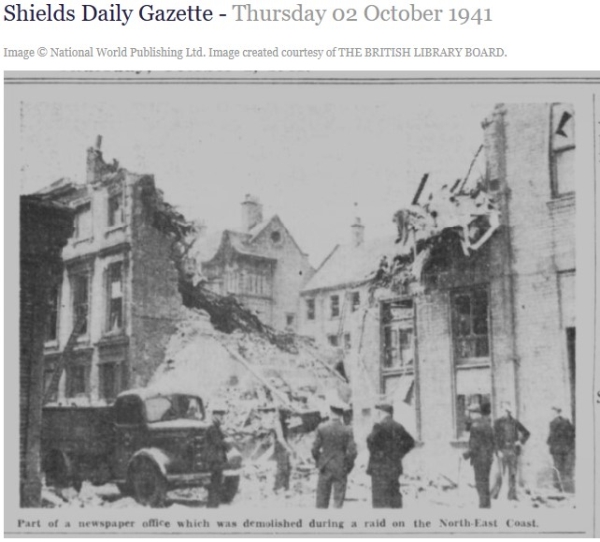
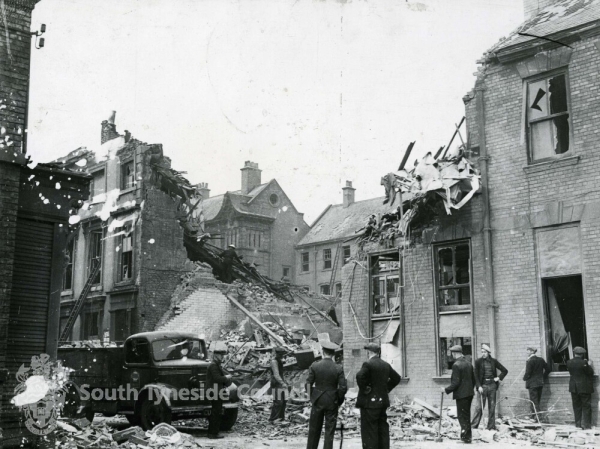
Luckily there were no casualties, the only occupants of the building at the time, firewatchers, being unhurt. One reporter, who was at the head of the stairs, had a nerve-wracking experience when, after being thrown down with the debris, he nearly stepped out of a hole in the wall into space: ARP Headquarters, (formerly the Gas Company Offices), was not much damaged but the properties on each side of it were shaken; other buildings in Barrington Street suffered minor damage. Another bomb dropped on the North-east corner of St. Hilda’s Churchyard. A large number of graves were disturbed.

Damage was done to the Gas Company purifiers, etc, adjoining Coronation St.; and the old Northern Press buildings at the corner of St-Hilda Lane, used for housing fire engines, was badly shaken. The roof and windows of the church were damaged and 150′ of the boundary wall was destroyed.
More “indiscriminate bombing” occurred at 21.40.when two 1,000kg. bombs fell in the Westoe district. One fell in the middle of the road at the Grosvenor Rd. end of Eastfield Road, shattered six houses and killed an ARP Warden as she was on her way to the Wardens’ Post; this woman was the first Air Raid Warden in South Shields to die from enemy action. The second bomb partly demolished the gable end of a house in Tynedale Rd. but did not explode; it embedded itself in a, garden between two houses & was subsequently removed by the B.D.S.; it was found to a “Herman”,1,000kg. Two bombs also fell in the vicinity of Chichester Rd., causing widespread havoc and some fatal casualties. One hit the rear of some tenement houses in George Potts Street; the backs of the property were completely torn off by the explosion although the fronts of the houses showed but little damage. These houses and an additional 79′ of property had to be demolished later.

The other bomb fell in a cutting on the Harton Coal Company’s railway between Laygate Schools and Chichester Place; 75′ of permanent way was torn up and one length of rail, 35′ long, was thrown on to the end of a house in Raglan Street by the force of the explosion; the roof was damaged and the rail fell into the street, blocking the roadway.

There were no casualties from this bomb but a compressed air pipe, 18″ in diameter, was broken and an electric cable severely damaged. Houses and sheds in Chichester Place suffered considerably and subsequent demolition was necessary.
At 21.50. two bombs fell on the vacant ground to the South of the Mill Dam, on the site of Forrest Hill; they exploded without doing any damage; but at the same moment a 500kg.bomb hit a block of residential property consisting of twelve houses in Cornwallis Square, destroying two and severely damaging others. A number of people, including two Air Raid Wardens, were hospital casualties. A fourth bomb, weighing 1,000kg. fell on the L.& N.E. Railway embankment & bridge near Portberry Street. The main line from South Shields was out of commission throughout the following day and a bus system was run between South Shields and Tyne Dock Railway Stations to cope with the passenger traffic of the railway. There were no casualties from this bomb.
One bomb was reported as having fallen into the river at 21.55. and at 22.05. the last bombs of this disastrous evening descended on Mayfair Gardens and Harton Cemetery. Of the two in Mayfair Gardens, one fell in a garden on the North side of the houses, causing no casualties but breaking windows and damaging roofs. The second scored a direct hit on two semi-detached villas which were completely pulverized. The inmates of these houses had taken refuge in a concrete shelter, constructed by one of the owners; they suffered from shock but there were no further casualties in the area.

In the Cemetery, one bomb fell in the garden at the back of the Lodge, seriously damaging greenhouses and horticultural stock. The other fell in the middle of one of the drives, completely blocking the roadway; this caused a certain delay to vehicles conveying fatal casualties to the Mortuary during the night.
Owing to simultaneous occurrence of the various incidents and the rapidity with which they took place, the above account does not necessarily indicate the correct order of the fall of bombs – 34 in all.
The Military Authority was asked to implement arrangements for giving aid to heavily bombed areas. Approximately 300 people were rendered homeless or evacuated; Feeding and Rest Centres were used, admitting 63 persons. No Incendiary bombs were dropped and the National Fire Service was only called out to attend to one fire.
| Casualties | Fatal | Seriously injured | Slightly injured |
| Male | 11 | 18 | 22 |
| Female | 6 | 26 | 9 |
| Children | 1 | 7 | 4 |
| TOTALS | 18 | 51 | 35 |
1941. October 2. 20.05. to 22.30
Tired workers had not had sufficient rest nor had essential services been fully restored when, on Thursday, October 2., the Luftwaffe carried out an even more intensive & determined raid on South Shields. In the short space of an hour and a quarter many parts of the town suffered from indiscriminate bombing & the Market Place was rendered almost derelict by High Explosive and resultant Fire.
The order of incidents in the following account does not necessarily indicate the exact numbering of the fall of bombs; the raiders crossed and re-crossed the town so often & so many areas were attacked almost simultaneously that it is difficult to ensure absolute accuracy. The times given, however, have been taken from the Police Records, based on reports sent in during the progress of the raid.
“Air Raid Damage. No. 26.”
“At 20.05 hours the Air Raid Message Red was received and the ‘Alert’ sounded. At 22.30. the Air Raid Message ‘White’ was received and the ‘Raiders Passed’ was sounded.”
A large number of enemy aircraft, flying at a low altitude, came in over the river. One or more of these planes succeeded in cutting loose some of the barrage balloons and it soon was evident that a heavy attack was developing.
The first bombs fell, far apart, at 20.55. One on a block of tenement houses in South. Taylor Street, where several dwellings were shattered, widespread damage caused to others and many casualties incurred.

The other dropped in Wardle’s Timber Yard in Long Row, where stacks of timber were damaged and a boundary wall was blown down, blocking the road leading to Brigham & Cowan’s Yard.

At 21.00. one bomb fell on a group of Council houses in Dean Crescent. Eight flats were demolished and considerable damage done to others, necessitating evacuation. There were a few casualties here but none fatal.
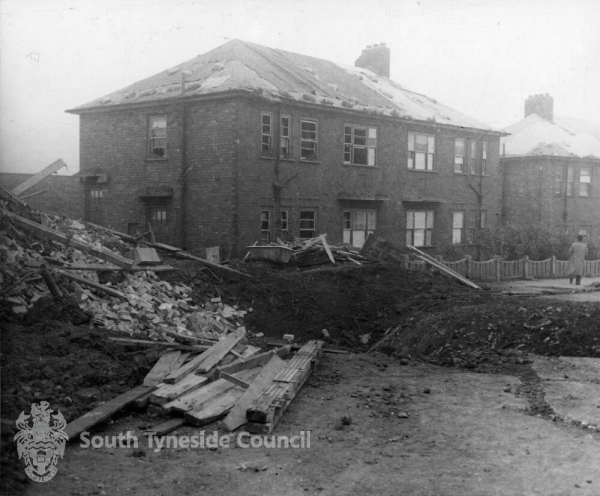
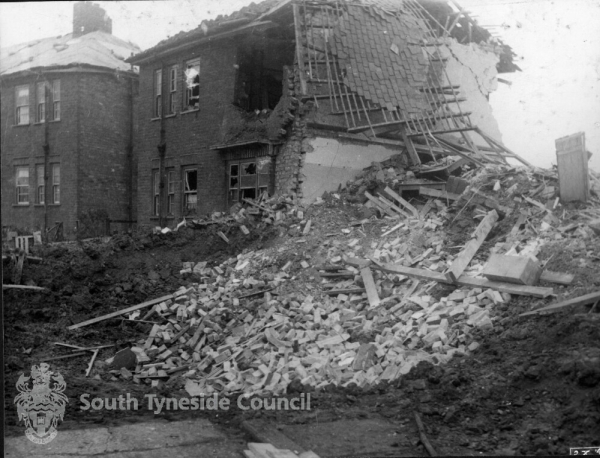
Eight minutes later, four bombs hit the residential area of Marlborough Street & Albany St. Owing to the rapid fall and concentration of these bombs, a terrific amount of damage was caused by blast; a large number of houses were reduced to rubble and many people were rendered homeless. Many more dwellings had to be demolished later, leaving a wide area of devastation. Some people were trapped in debris or in their shelters and casualties were fairly numerous. One Special Police Constable, on duty in Marlborough St., was killed.
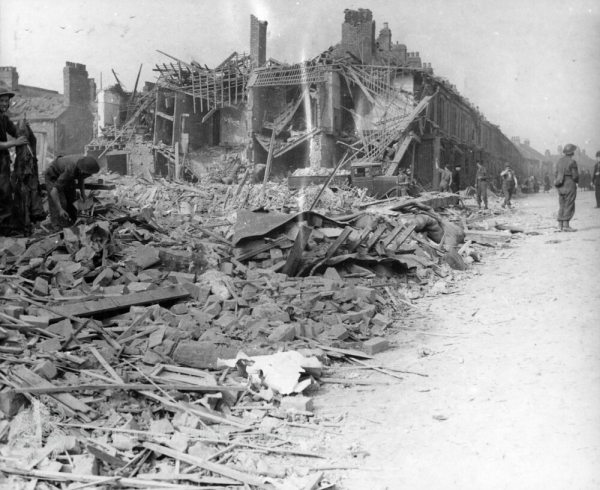
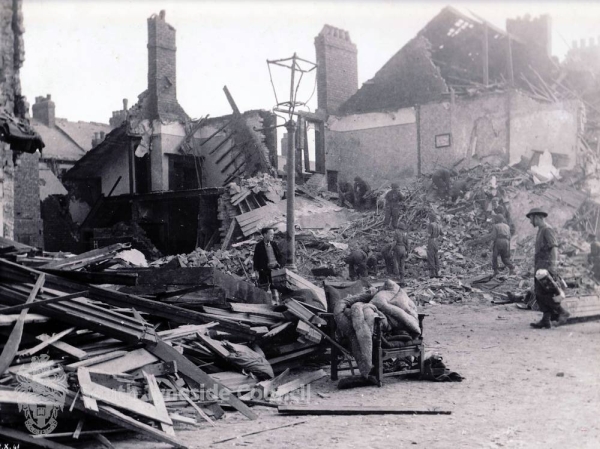
The attack was, then carried, at 21.20., to the riverside, the Market Place and the neighbourhood of Westoe Cemetery.
Three bombs fell, doing little damage, near the river. One on vacant ground above Comical Corner; another on the new road in Shadwell Street, where the concrete surface of the road and adjoining railway lines were torn up; and the third on the new quay, then in course of construction, near Pilot Street, where the crater measured 50′ x 14′.
A stick of bombs dropped over the Market Place caused, by explosion and fire, some of the worst damage of the raid.
One fell on vacant ground between the foot of River Drive and the Tyne Dock Engineering Co.’s premises in Thrift Street. An Air Raid Warden on duty in River Drive was killed by blast and on the North side of the Market Place a Messenger was seriously injured. Another bomb fell on Dunn’s Paint Stores and shop, completely demolished the building and started major fires.

Two more fell in the Market Place; one on the entrance to the shelter under the South-east quarter, near East Street, and the other on the shelter in the North-east quarter. At the former point the explosion fractured a gas main which burst into flame and set fire to a trolley bus standing by the pavement.
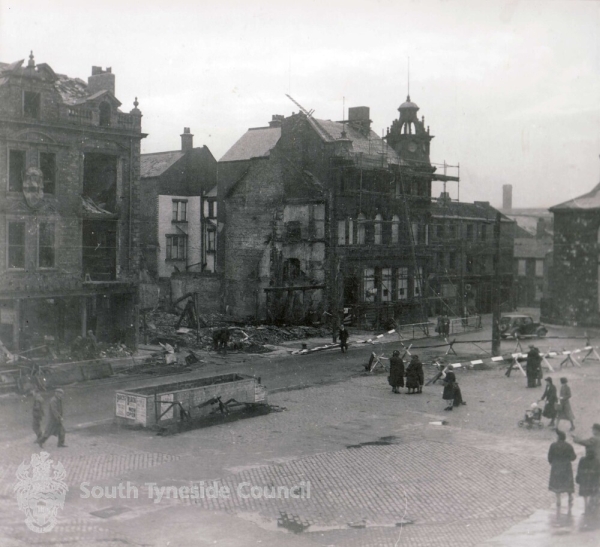
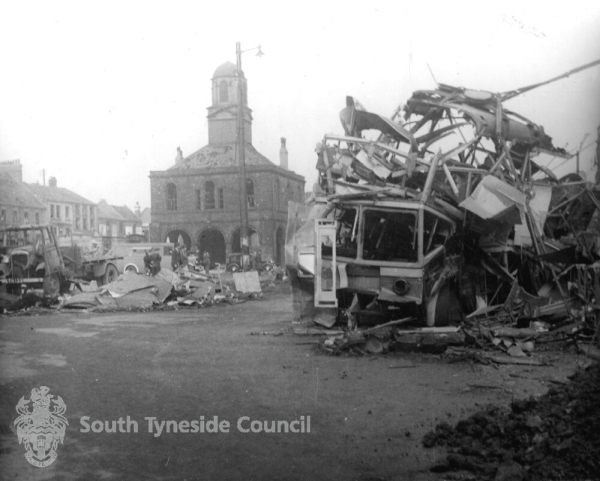
Both fires increased and spread to adjoining buildings, necessitating a call for “Mutual Aid”? Millers Stores were soon involved; the flames crossed East Street and spread to the “Tram Hotel”, the “Grapes Hotel”, Jackson’s Clothing shop at the corner of King Street and the King’s Shoe Shop. The whole of this block was ablaze and had it not been for the solidity of the dividing walls at Lipton’s and Mason’s shops, the upstairs portions of which were involved, the fire might have caused much more damage in King Street.

The fire started by the explosion in Dunn’s Paint shops spread to Hanlon’s shop, the “Locomotive Hotel”, Campbell’s Lodging-house and the “Union Flag” P.H.

Cans of burning oil and paint were hurled into the air and started fires in the “City of Durham’ P.H., the “Metropole Hotel” and the “Imperial Hotel”;
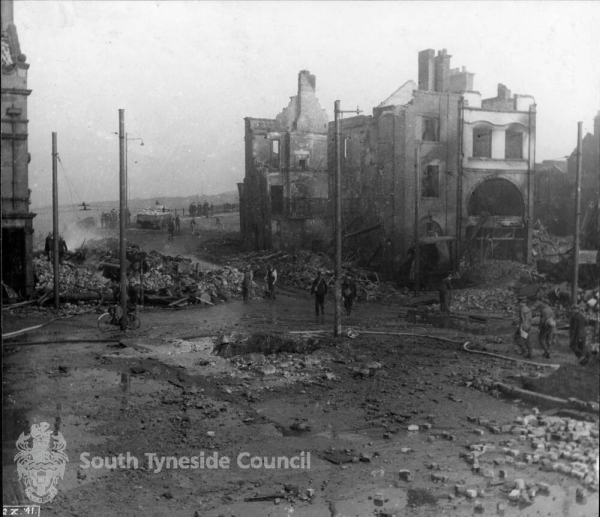

Crofton’s Drapery Stores at the corner of King Street started to burn from a leaking gas main and was, in a very short time, enveloped in flames and the fire soon spread to Woolworth’s Stores, adjoining, which was completely gutted. The side entrance to the Regal Theatre and Galt’s Fruit Store in Union Alley were also damaged by fire.
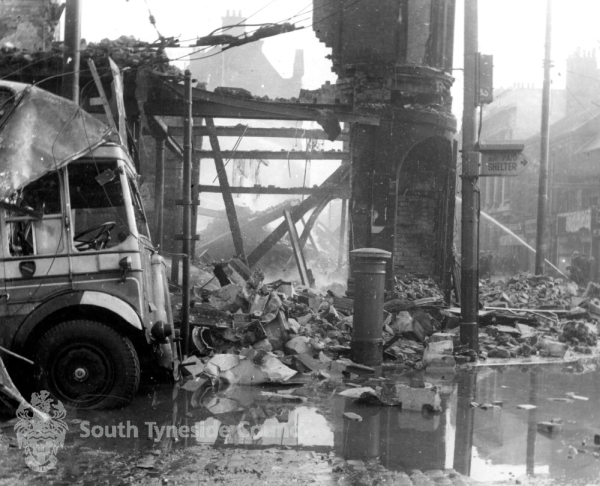
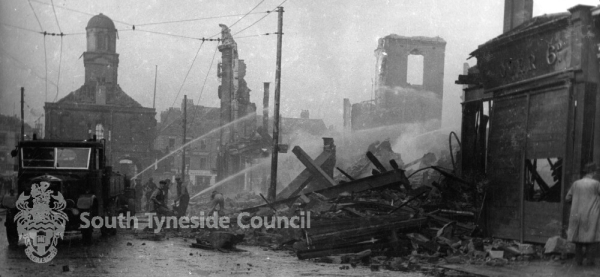
Owing to the fact that the mains were badly damaged, water had to be relayed from the Ferry Landing and the National Fire Service Static Water tank in North Street. By daylight all the fires were under control but it was not until mid-day on October 3. that the burning gas main outside the Water Co.’s Offices could be extinguished as the stop tap to cut off the gas could not be found.
** The National Fire Service Report reads:-
“The following is a list of fires which occurred in the Market Place, in the order in which they occurred:- Trolley bus and gas main opposite the Water Co.’s Office;
Crofton’s Ltd.;
Dunn’s Paint Stores;
Tram Hotel; Jackson’s,(Tailors)
City of Durham Hotel.
Despite many rumours at the time, the loss of life in the Market Place shelters was comparatively small, (12 killed and 5 rescued)?

This was partly due to the fact that as the road to the Market Place from Union Alley had been blocked in the previous raid, many people from the cinema had to go in the opposite direction to the shelters in North Street. Three men on their way to work were crossing the Market Place as the bombs began to fall; one took refuge in the shelter but was wounded, the second was killed just outside the shelter and. the body of the third was never found. It was suspected that he had been blown by blast into the burning paint shop but long-continued digging to recover his body was without result.
At daylight on Friday morning, the Market Place looked like the ruins of Ypres;

nothing could be seen but broken buildings; the square was littered with debris and a tangle of fire hose; all the remaining windows in St. Hilda’s church were shattered, the roof dislodged and the old stone walls pitted and scarred with shrapnel.

The Old Town Hall suffered heavy interior harm and none of the business premises was left intact.
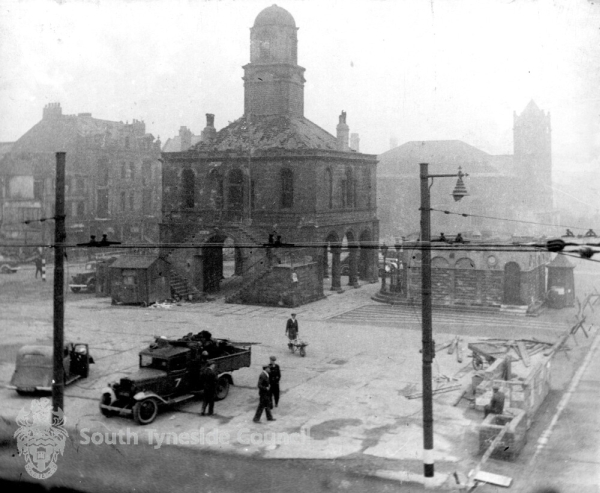

All the overhead wires were down and it was not until the afternoon of October 9. that buses were able to pass along King Street.

At the same time, (21.10.), two bombs fell near the Westoe Cemetery. One on the unmade road in Candlish St., between the Mica Lubricant Works and dwelling-houses opposite, damaged the works severely and totally destroyed six houses.

A large number of people were rendered homeless. There were no service mains affected but one fire was started, requiring the attention of the N.F.S. who soon had it under control. The second bomb fell in the Harton Coal Co.’s railway cutting adjoining Erskine Road, at the end of Selbourne Street. The track was torn up and an electric power cable, the property of the N.E.E.S. Co., took fire.

As it was impossible to get the current turned off locally, it is probable that the light from the burning cable was the cause of a concentration of bombing which occurred about a quarter of an hour later; for, at 21.23., Hyde Street and Wharton Street were the scene of many casualties & great damage. One bomb fell in the centre of a block of property in Wharton St.; six houses were razed to the ground and many more were made unsafe. Two more bombs fell nearby in Hyde Street where twenty houses were destroyed & a large number damaged. In both these streets people were trapped under debris or in their surface shelters and some-of the casualties were fatal. Small fires broke out under the wreckage; human chains were formed; buckets of water were passed along and the flames were promptly put out. Gas & water mains were affected and upwards of forty houses had to be taken down later. A large number of people were thus homeless and many of them were accommodated in Rest Centres.
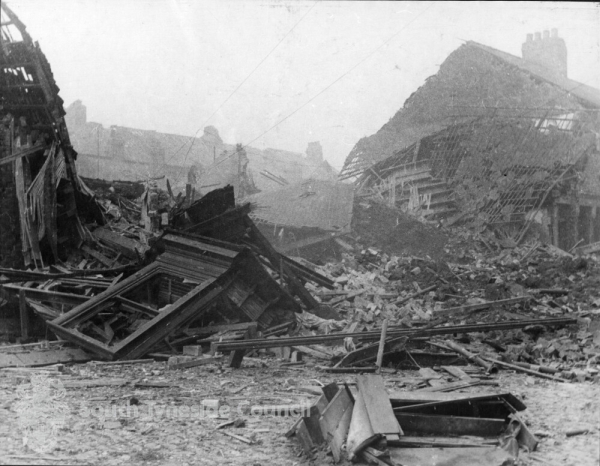
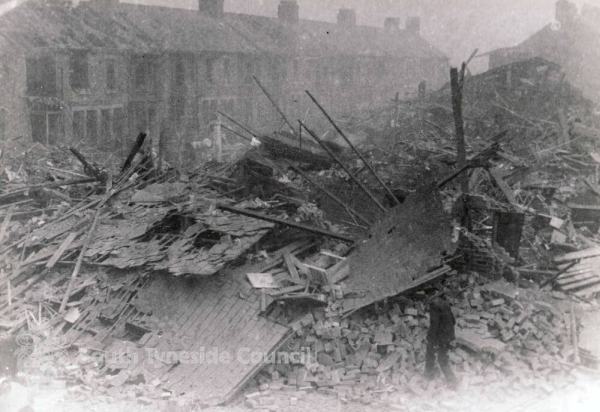
At 21.25.several incidents occurred in various parts of the borough. In Thrift Street one bomb fell between the fitting shop and No.1. Dock of the Tyne Engineering Co.’s Repair Yard. It wrecked the side of the dry dock, lifted a ship, weighing 570 tons, off the keel blocks & laid it on its side on the opposite side of the dock.
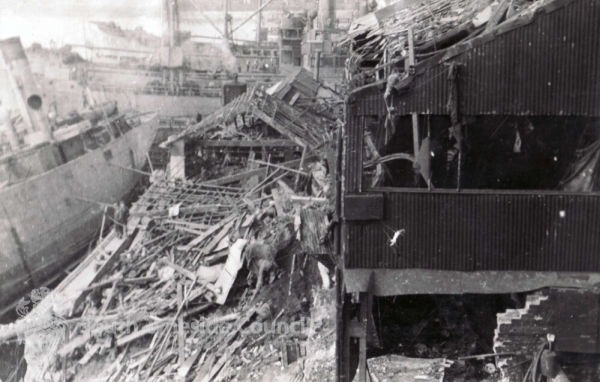

Much damage was done to the fitting shop, the plumbers’ shop, the Blacksmiths’ shop and the stores but there were no casualties. Another bomb fell in a newly-constructed power house at Brigham & Cowan’s dock near Long Row. It demolished the building and the dynamos and generators therein. Much damage was done to a partially completed structure and the end of a new dock. A roll of cable, standing close by, was lifted up and thrown across the dock on to the roof of a fitting shop. Water & gas mains were injured but there were no casualties.
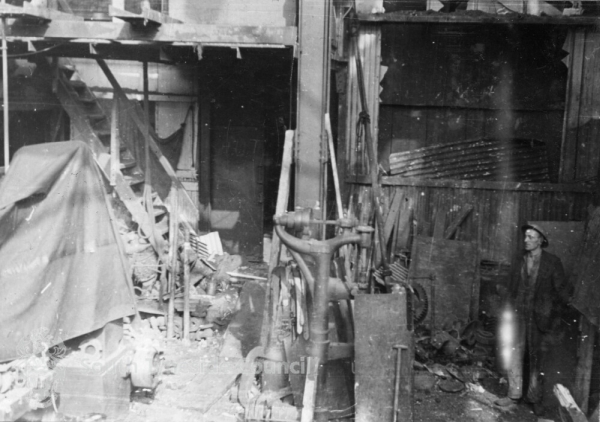

In Winchester Street, a block of six houses on the North side were demolished by another bomb. One woman was killed when the shelter collapsed over her and others sustained injuries requiring medical attention.

Serious damage was caused to property in the vicinity. Nearby, in Anderson Street, a bomb fell in the middle of the road between Challoner Terrace East & West. It wrecked houses on either side of the road and a number of people were trapped in the basements; some were dead when, by strenuous tunnelling & digging, they were extricated.
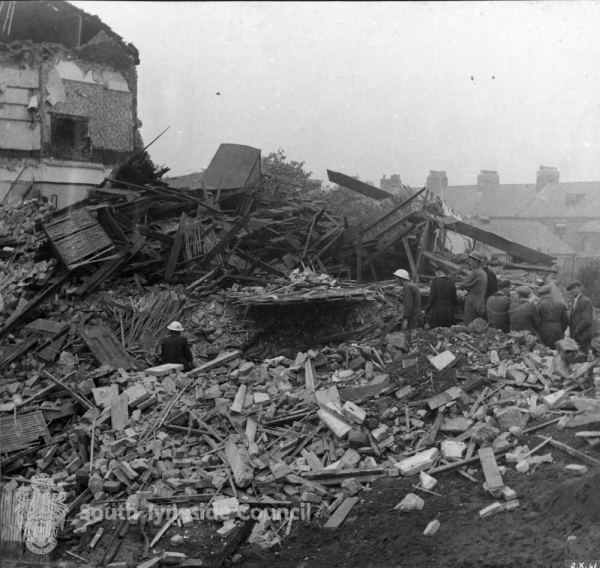
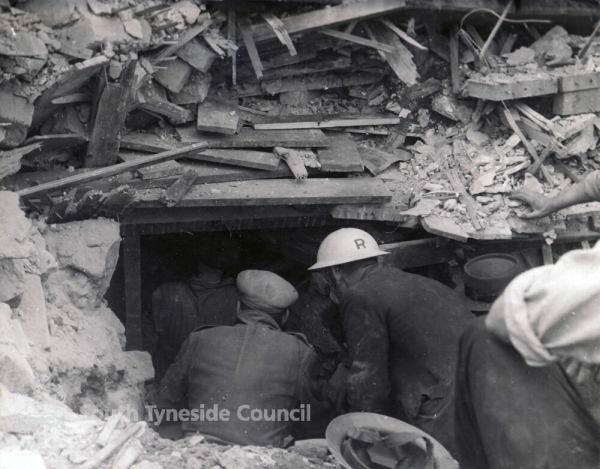
Severe damage was done to the Jewish Synagogue and to dwelling houses in Ogle and Wellington Terraces. Service mains were seriously affected. At the other side of the Town Hall, another bomb fell on a block of houses in Broughton Road, between Bolingbroke St. & Berkeley St. It demolished the whole row of houses except one which was beyond repair. A number of people were trapped in back-yard shelters, several of whom were dead when extracted. Gas mains were affected and both roads were blocked.

Two more bombs fell in Bents Park Road but both were found unexploded. This road was closed to traffic until the Bomb Disposal Section removed the bombs on October 7.

Between 21.28. and 21.43., the Percy Street-Derby Terrace area was the target for a number of bombs, 8or 9 in all. Two fell in Percy Street; one completely wrecked ten houses at the corner of Readhead St.; many people were trapped in shelters and many houses, previously damaged by bombing, had to be condemned. The second bomb fell on the side of Percy Street nearest to the bridge but as this ground had been cleared after earlier bombing, no harm was done except to a water main. At the junction of Isabella Street & Elizabeth Street, a bomb which fell in the middle of the road caused a large amount of damage; owing to its position, the blast swept down four ways, destroying- a number of houses on each corner, fracturing a sewer, gas, waters mains and an electric cable.

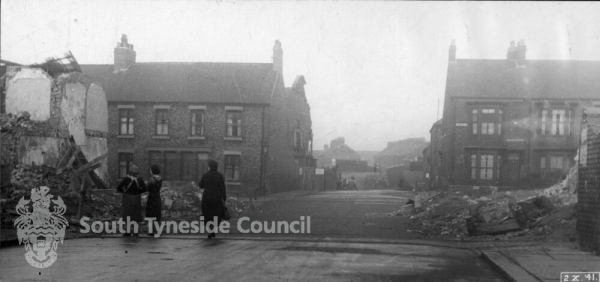
A number of casualties were incurred. The L.&.N.E. railway line was the next objective when two bombs scored near masses near Garden Street, one fell on a garden which was completely obliterated; and the other in St. Hilda Colliery Yard, behind the Gas Works, where railway lines and points were damaged but there were no casualties. A few yards away, a scene of utter confusion was created in ground behind the Garage in St. Hilda Street . The explosion of a bomb threw a number of cars and light Army vans into many curious positions; severe damage was caused both to vehicles and to adjoining sheds but there were no casualties.

Within the next five minutes, (21.37. to 21.42.), three bombs fell in close concentration at the junction of Derby Terrace, Isabella Street, Derby Street and the bridge. The gable ends of the Corporation Baths and St. Bede’s School were both ripped off; an air raid shelter in the school yard was destroyed; the foot of the “Pulley Bank Bridge” was torn up and masonry twisted; and St Andrew’s Mission received such a shaking that it had to be condemned. There were no casualties from these three bombs but the G.P.O main telephone system was disrupted at this point, thus paralysing communications for some hours; and the main roads were blocked, which greatly impeded the progress of Rescue, Ambulance and other vehicles.

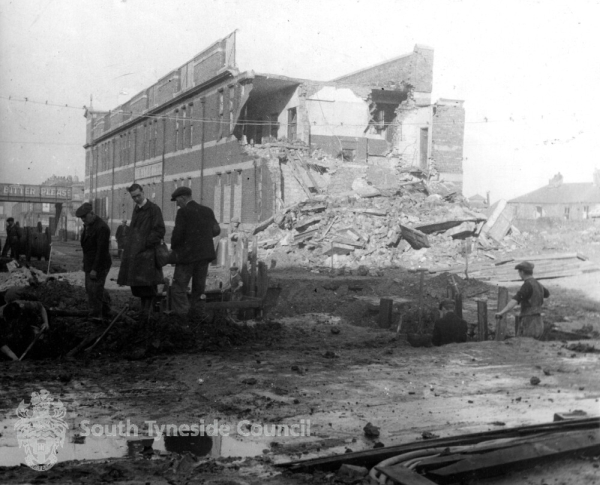
To add to the difficulties of transport, another major road was closed when, at 21.40., a heavy bomb just missed the railway bridge at the junction of S. Eldon Street & Temple St.. A crater 70′ in diameter was made in the concrete surface road; the buttresses of the bridge were damaged; overhead wires were brought down; and gas, water & electric mains were affected. There were no casualties at this point but, a short distance eastward, a considerable number of people were buried in their surface shelters or in debris when another bomb hit a block of tenements in South Eldon Street; eight flats were completely shattered and others severely damaged. Some of the shelters were thrown on to the edge of the crater and others were hurled among the debris of the houses by the force of the explosion.

A short distance away, two more streets were hard hit when a heavy calibre bomb fell in the back lane between Lytton Street and H.S. Edwards Street, devastating a number of dwellings. Twelve were wrecked or buried in debris and most of the occupants were dead when they were, with great difficulty, extricated by digging. The horror of this incident was made worse by the danger of flooding from a broken water main, which also impeded the work of Wardens, Rescue and Ambulance Parties.

At 21.55., two bombs fell on the concrete surface road in Pier Approach, East of the Wouldhave Memorial. 2 large craters blocked the entrance to Sea Road; the railings & shrubbery of the South Marine Park were uprooted and severe damage was done to Parker’s Café, to the roof covering the old “Tyne “lifeboat and to the boat itself. The Wouldhave Monument was scarred by flying debris and the clock faces and mechanism were broken. A minute later, a third bomb hit a block of houses in Pollard Street. Five houses were shattered & many more affected by flying glass and shrapnel. Five people were buried in shelters behind the houses but they were all got out alive, sustaining no physical injury. Gas mains were damaged.


At 22.00. one bomb fell on railway lines near Crawford St., scattering railway trucks and damaging garden huts and pigeon lofts. There were no casualties.
One of the heaviest bombs of this raid fell, at 22.05. on Queen Street, between Station Approach and Mile End Road. It completely demolished all the houses on the North side, amongst which was Chipchase’s Tripe Shop which had remained practically unaltered since 1832, and the rear of Moorhouse’s Furniture Store in Mile End Road. A large number of casualties occurred here, many people being buried under the debris of ten or twelve houses. To add to the difficulties of rescue, the crater, 80′ in diameter, began to fill with water from a fractured main. Business premises in this part of King Street suffered, some of the outbuildings at the back being shattered. From the “kopf ring” found on the lip of the crater it was judged that the bomb weighed about 1,800 kg.

After this major disaster, the last bomb of the evening fell in St. Stephen’s Churchyard, immediately behind Military Road & near a large block of flats. A number of graves were disturbed and some damage done to property but there were no casualties.

In addition to the two bombs in Bents Park Road, three unexploded Anti-aircraft shells were found in different parts of the town. One in Centenary Avenue, which was taken to ARP Headquarters; one in Barnes Road & another in Francis St.. All were dealt with by the B.D.S.
The calibre of the 44 bombs that fell in this raid was between 1,000 and 1,800 kg.
The value of “Mutual Aid” was vividly demonstrated on this occasion. The ARP Rescue Service, which did magnificent work, was assisted in its heavy task by forty men from Gateshead, sixty from Newcastle and thirty from Sunderland. Divisional Aid was given in fighting the terrific fires; and Police from neighbouring towns were drafted in to relieve in cordon and traffic duties. Help was given in these matters by the Army, which also assisted in the work of demolition of unsafe buildings and removal of furniture, together with a party of Naval Personnel from the North Shields Naval Base. The Hedworth Hall was opened for the feeding of personnel engaged in this valuable help; at noon on the following day, a unique spectacle was to be seen in Dean Road – fire engines & other vehicles from all over the county being parked along the road from the Regent to Chichester Crossing.
About 2,000 people were rendered homeless, of whom 374 were accommodated in five Rest Centres. The Civil Defence Services were greatly helped by the of the inhabitants in this, their greatest ordeal.
It has been estimated that 240 dwelling houses, offices and shop were destroyed at the time or had to be taken down later. Upwards of 2,000 suffered less heavily. Seven trolley & motor buses were more or less seriously damaged & it is noteworthy that one the Cleadon buses, burnt out in the Market Place, was reconditioned and used by the Transport Department for some years afterwards.
| Casualties | Fatal | Seriously injured | Slightly injured |
| Male | 34 | 67 | 54 |
| Female | 22 | 37 | 30 |
| Children | 12 | 13 | 7 |
| TOTALS | 68 | 117 | 91 |
| Casualties | Fatal | Seriously injured | Slightly injured |
| ARP Wardens | 1 | 2 | 7 |
| Messengers | 1 | 1 | |
| Sp. Constables | 1 | 1 | 1 |
| Fire Service | 1 | 3 | 5 |
| Firewatchers | 2 | 1 | |
| TOTALS | 5 | 8 | 14 |
1941. October 8. 21.33 to 22.20.
Two “D. Type” parachute mines fell on railway lines; one on the L.& N.E. Railway main goods line at Tyne Dock, 100 yards South-west of Wright’s Biscuit Factory; the other near Leam Lane Bridge. The only damage, other than that to the permanent and nearby trucks, was to window glass in houses in the vicinity. There were no casualties.
1941. December 8. 22.12. to 00.39.
Nine H.E. bombs were dropped in this raid. One at the corner of Beach Road and Bents Park Road made a large crater which, owing to a fractured water main, filled with water & blocked the road. The Brough Holiday Home received superficial damage.

Houses at the North end of Nelson Avenue were damaged by a bomb which fell on open ground in front of them. Two houses at the junction of Nelson Avenue and Erskine Road East were totally wrecked by another; the occupants of a Morrison table shelter were rescued uninjured. Another bomb fell in the Bents allotments nearby, doing much damage to gardens and huts. The remainder of the bombs fell on open ground between Trow Rocks and Marsden Bay. There were no fatal casualties but two people were injured.
1942.
March 8. 02.59. to 03.45.
Two parachute mines fell on railway lines at Tyne Docks near Leam Lane. No casualties but the permanent way was torn up.
1942. April 15. 23.50. to 01.20.
At 00.45 on the 16th., four bombs fell in the grounds of residential property in Westoe. The first, on the edge of a field at “Seacroft”, failed to explode and was dealt with by the B.D.S. at a later date.
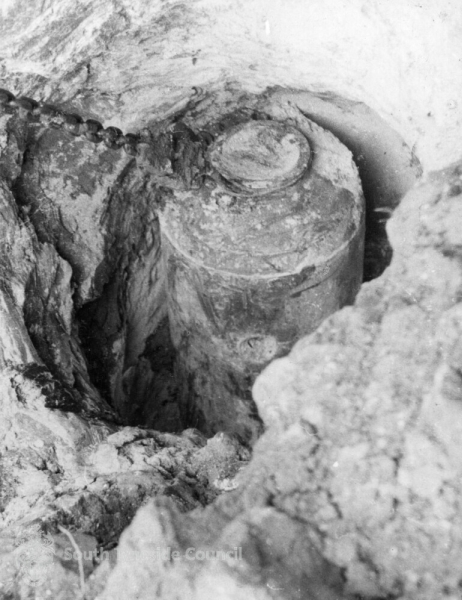
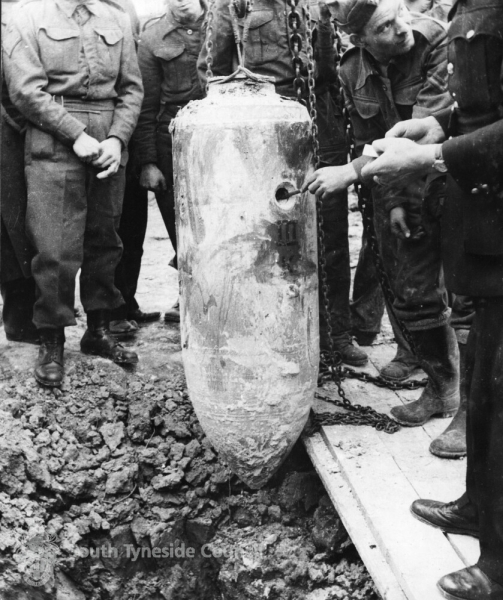
The second and third fell in the gardens of “Fairfield” and “Eastgarth” respectively. The last one on the lawn 10 yards from “Chapel House”.
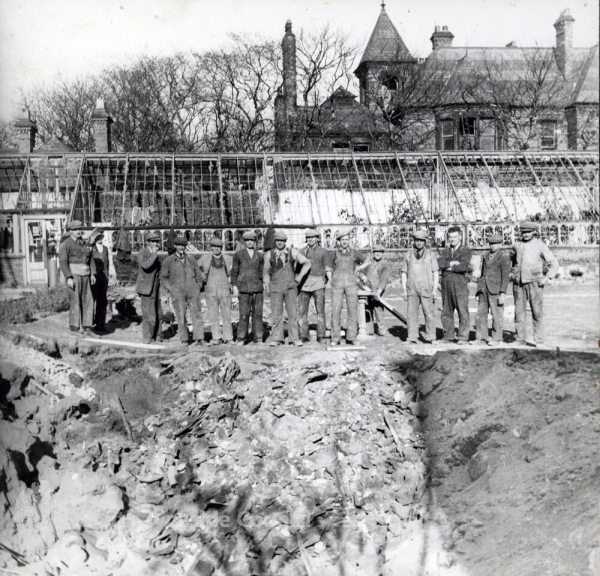
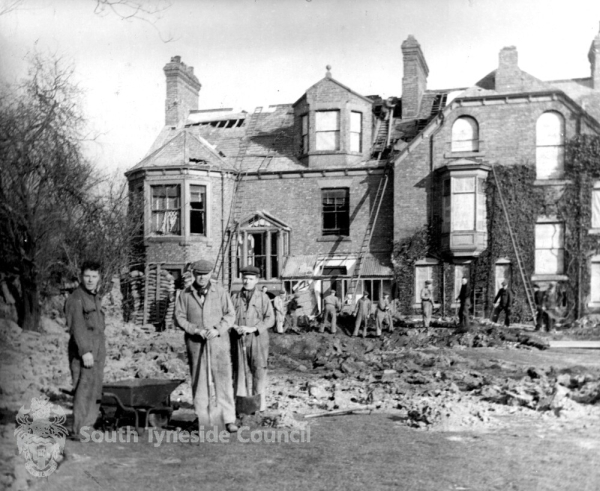
No casualties were reported but considerable damage was done to a large number of houses in the neighbourhood, including over forty roofs of houses in Horsley Hill Road which were penetrated by lumps of clay thrown up by the explosions.
1942. May 1. 03.35. to 04.05.
One H.E. bomb fell near St. Hilda Signal Cabin on the L.& N. E.R. main line. Shortly afterwards a second bomb was dropped in a field 200 yards South of Richardson Terrace, Simonside. No casualties were reported.
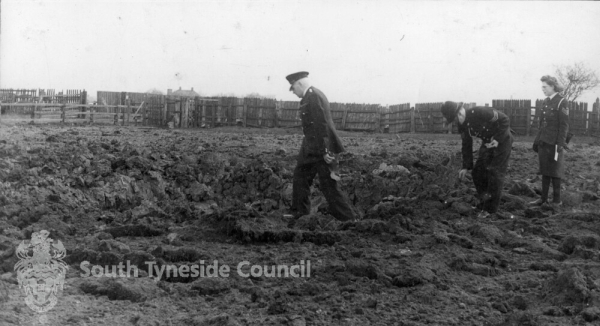
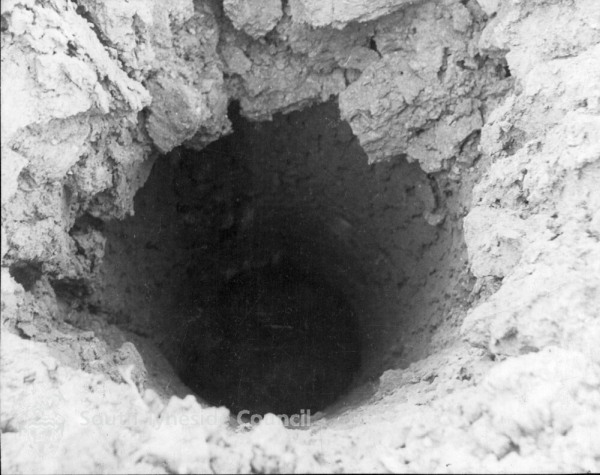
At 04.02. about 100 Incendiary bombs fell on the North foreshore. Two unexploded incendiaries and four carrying rows were found. During the progress of this raid two Anti-aircraft shells fell on the dock wall of Tyne Docks Basin and on the railway lines in Tyne Docks near the River Street entrance. Slight damage only was incurred and there were no casualties.
1942. August 9. 23.25. to 00.43.
Sixteen flares and approximately one hundred Incendiary bombs fell on the Harton and Westoe districts. No damage and no casualties were reported. Two unexploded bombs were found.
1942. September 19. 21.48. to 23.32.
Eight H.E. bombs and about 600 Incendiaries were dropped in this raid, on the Bents Park, Erskine Road & Simonside respectively. The first “Camouflets” in the Borough were discovered in Erskine Road, the Bents Allotments and Bent House bridle path. No damage to property and no casualties were reported.
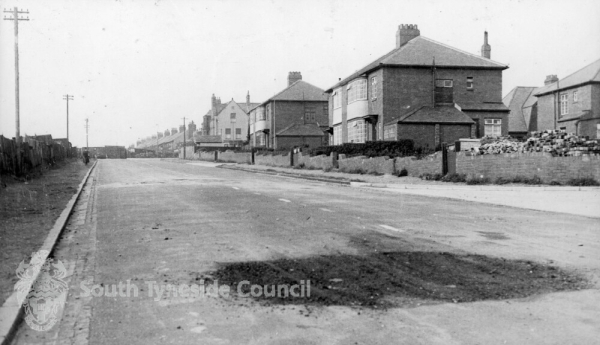

1942. October 11. 21.05. to 22.08.
“Spring-band” bombs containing 30 lbs of High Explosive, 6 “Fire-pots” and small incendiary pieces were used in this raid; the total weight of each bomb being 50 kg. Sixteen buildings were damaged by fire & twenty-eight pumps were employed to extinguish the flames. Severe damage was caused to both industrial and residential premises. In the Gas Works a joiners’ shop, (the old Union British School), was gutted and the base of the gas-holder damaged by fire.

A ship in the Middle Docks and the gates of No.3. Dock were damaged.
A crater in the middle of the roadway in Sunderland Road, a few yards South of the entrance to the Cemetery Drive, necessitated traffic diversion and a 12″ water main was burst.

Two camouflets were found; one behind a house in Sunderland Road and another in a front garden about half way up Mayfair Gardens. At the top of Mayfair Gardens one house was wrecked and several others were severely damaged.
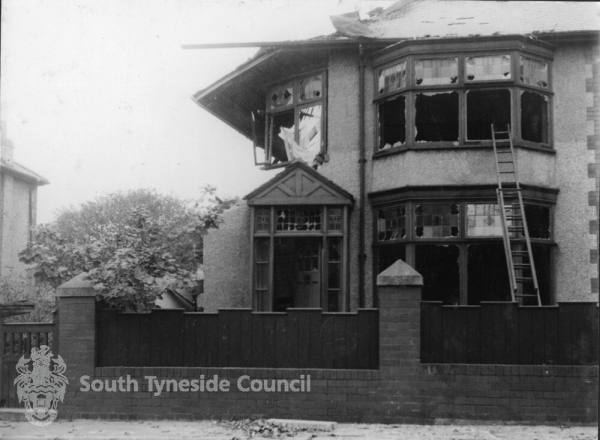
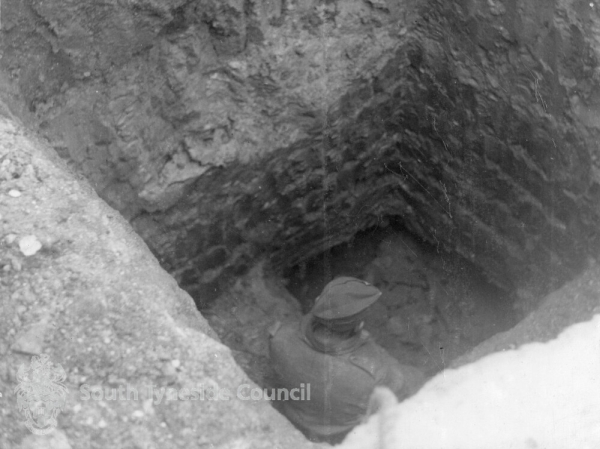
The back of the Cemetery Lodge was torn open by another bomb; one camouflet was found near one greenhouse and another bomb wrecked a small greenhouse and boiler-house. Two of the “Spring-bands” fell on roads in the Cemetery.
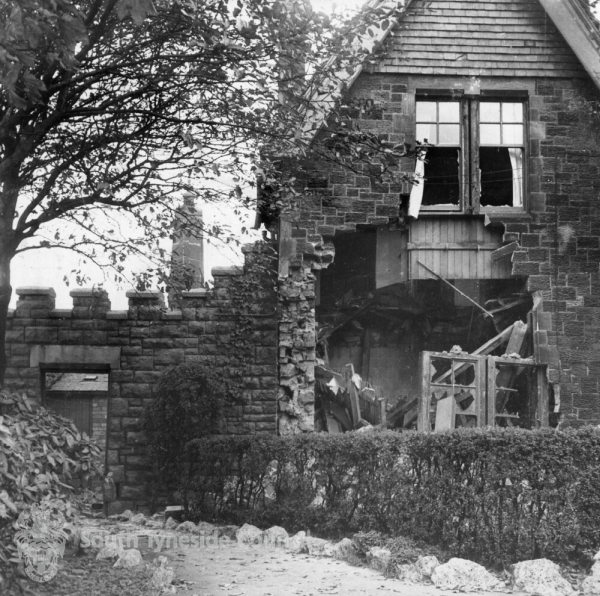
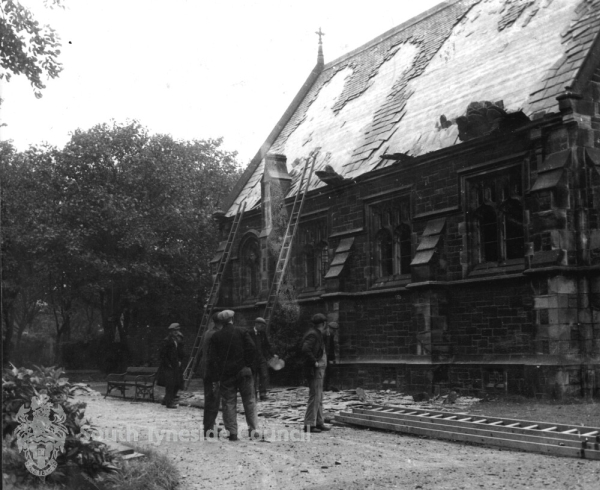
One large H.E. bomb fell in the middle of a burial section and did much damage to graves and to the roof of the North Chapel.

Twenty-three persons were rendered homeless; they were all accommodated by relations or friends and no Rest Centre was in use.
| Casualties | Fatal | Seriously injured | Slightly injured |
| Male | 1 | 5 | 3 |
| Female | 2 | 3 | |
| Children | 1 | 1 | |
| TOTALS | 2 | 7 | 7 |
1943.
1943. March 12. 21.12. to 22.45.
One of the more serious raids occurred on this date, when wide-spread devastation was caused in a single area. Happily the casualties were few but the material damage was immense. Eight dwelling-houses were totally shattered and twelve others so severely damaged that demolition was needed. Approximately 250 others suffered less heavily in the Cauldwell area and countless windows were broken still further afield.
Shortly after the “Alert” sounded, flares were dropped and at 21.25.hours, three H.E. bombs fell as follows:-
1. 250 kg. on a house at the corner of King George Road and Page Avenue.

1. 1,000 kg. on houses at the junction of Cauldwell Villas and Stanton Avenue.

1. 250 kg. on an allotment near Cauldwell House.
The crater in Cauldwell Villas was one of the largest made in the Borough;
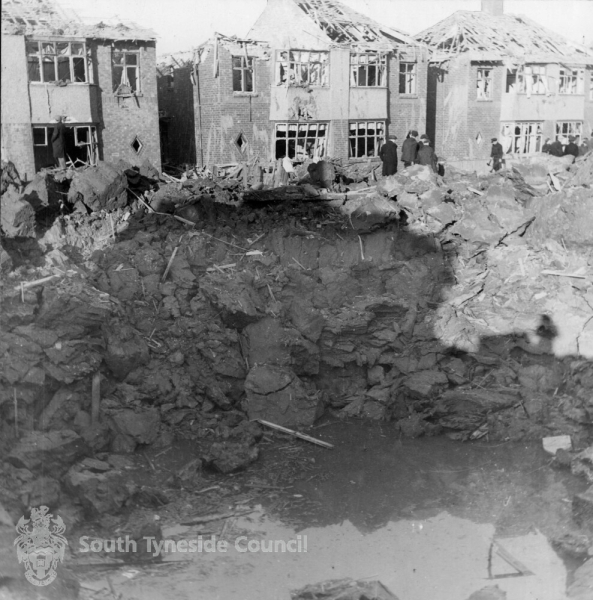

shelters were found on the lip, completely covered by lumps of clay, but the occupants were all rescued alive. One house was obliterated and several more shattered.
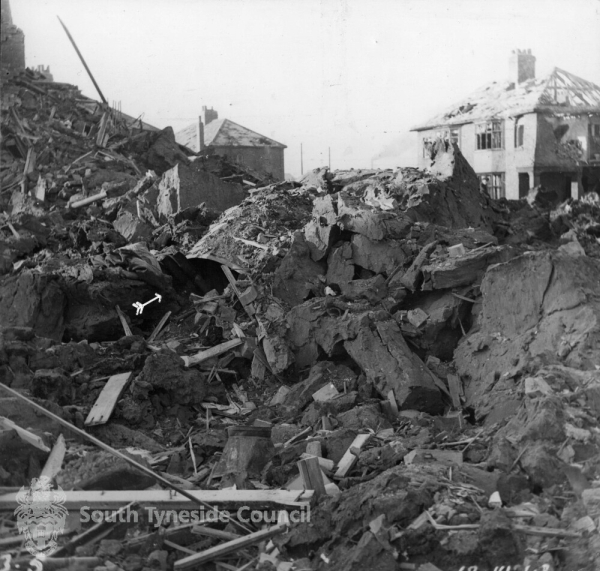
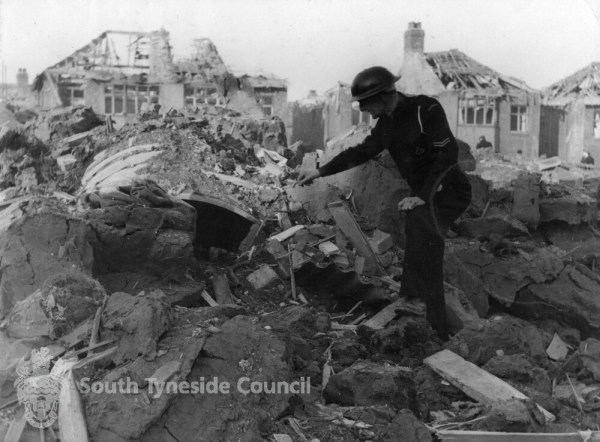
At the corner of Page Avenue two houses were totally wrecked, and others damaged.
About 60 people were rendered homeless, many of the more severely damaged houses having to be evacuated but all were taken to the homes of relations of friends.

The one fatal casualty was not a resident of the neighbourhood; the body of a young man was found under the debris in the roadway of Cauldwell Villas.
One water main in Cauldwell Villas and four gas mains were burst; one electric main cable was damaged and the overhead trolley wires were brought down in Mortimer Road.
Incendiary bombs were also dropped. Four hay-stacks in a farm-yard at Simonside were destroyed by fire caused by one of the flares.

| Casualties | Fatal | Seriously injured | Slightly injured |
| Male | 1 | 2 | 3 |
| Female | 3 | ||
| Children | |||
| TOTALS | 3 | 2 | 5 |
1943. May 16. 01.42. to 03.08.
3 galvanised metal Containers fell in a residential area. 2 failed to open but the third liberated a quantity of papers, the text of which reads:-
“Here is the reason why the British Government says nothing about shipping losses.”
A list of 412 British ships, supposedly sunk from June, 1941, followed. (Four of whom were actually in the Tyne at the time of the raid.) 5 more Containers were found on Cleadon Hill.
1943. May 24. 02.45. to 04.10.
The last raid in which bombs were dropped, and one of the more serious as regards loss of life and property, was on the Westoe and Cauldwell areas when 4 H.E. and 4. Phosphorous bombs were used.
At 03.19.hours, H.E. bombs fell as follows:-
1. 500 kg. on Marsden Street;
1. 500 kg. on Stevenson Street;
1. 500 kg. on Dean Road;
11. 500 kg. on Hepscott Terrace.

These were Percussion bombs, supposedly fitted with rods on the nose of the bomb. They exploded before penetrating the surface of the ground and therefore there were no craters but the area damaged was very large. The floor-boards of a downstairs flat in Stevenson Street were undamaged although the entire building above ground was shattered.

About twenty dwelling-houses, shops, and the front of the ARP Stores at the Regent Garage were completely shattered and many more had to be demolished later. About fifty other shops and houses were seriously damaged and five hundred other properties, including the Regent Cinema and the Roman Catholic School, then at “Wyvestow Lodge” suffered. The Dean Road Wardens’ Post was damaged, as was the entrance to a Public Shelter adjoining. The bomb fell on the road between the Regent Garage and the Wardens’ Post opposite. There was no crater but the tramlines were torn up and a water main burst. Another water main at the end of Hartington Terrace was also damaged.
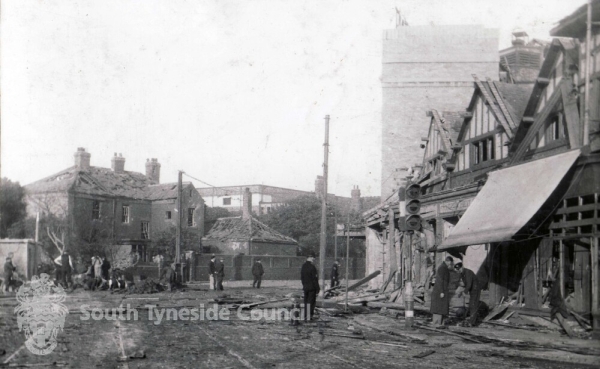
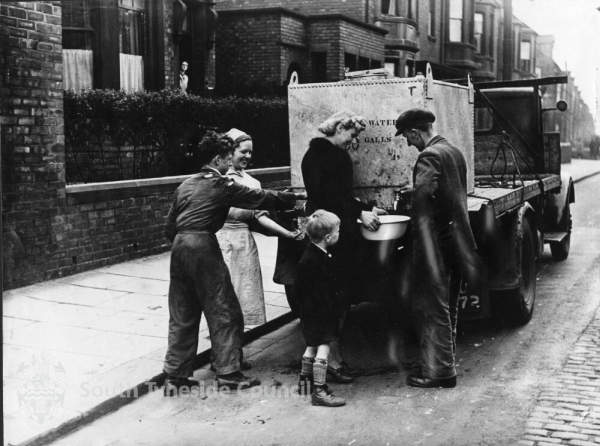
Owing to the densely populated nature of the Marsden St. district, casualties were heavy and material damage widespread. Unhappily the Police Force and ARP Service suffered the loss of one Regular Police Officer, three Wardens and one Fireguard. 300 people were rendered homeless and temporary accommodation was provided at a Rest Centre.

The siren on the roof the Regent Cinema was put out of action. The Phosphorous bombs all fell harmlessly on fields at Harton Moor and Cauldwell.
| Casualties | Fatal | Seriously injured | Slightly injured |
| Male | 21 | 14 | 8 |
| Female | 3 | 10 | 11 |
| Children | 2 | 3 | |
| TOTALS | 26 | 24 | 22 |
1944.
May 25. 03.10. to 03.27
There were no incidents within the Borough; a Flying bomb, liberated from a long-distance plane, crashed inland.
1945.
March 4. 01.10. to 02.37.
After a long period of immunity from raids, an inexplicable incident occurred when a plane, flying low over the North-east corner of the town, fired cannon shell over a line of houses from Green’s Place to Sea Way. Incendiary cannon-shell caused two minor fires. There were no casualties reported.
OFFICIAL STATISTICS.
Concerning Enemy Air Raids on South Shields.
Official Statistics concerning enemy air raids on South Shields reveal that since the first bomb dropped in June, 1940:-
156 people were killed;
211 people were seriously injured;
353 were slightly injured;
3,147 persons were rendered homeless.
39 shops & offices and 443 houses were demolished;
67 shops & offices and 1,257 houses were seriously damaged;
2,604 premises received damage to glass only.
249 Alerts were sounded.
179 High Explosive bombs and 16 Parachute Mines exploded in the Borough;
9,312 Incendiary bombs fell.
(Shields Gazette: October 12. 1944.)

Sources:
British Newspaper Archives
Photographs of damage by enemy action in the Borough of South Shields. 1940 to 1943 by Amy Flagg, copy in The Word Library.
Shields Gazette, Mike Mulhern
Terry Ford
Photos:
South Tyneside Libraries
Terry Ford
